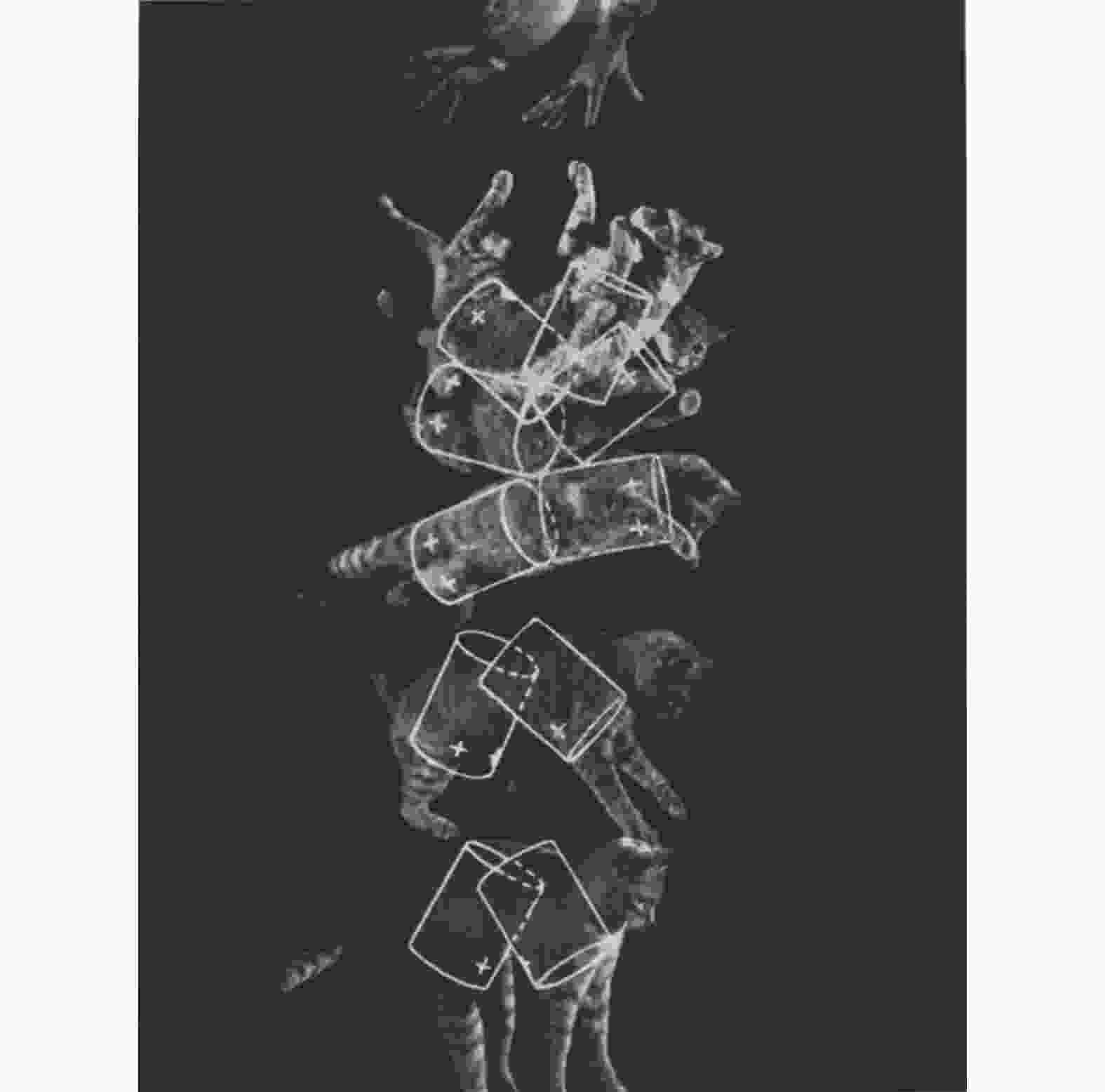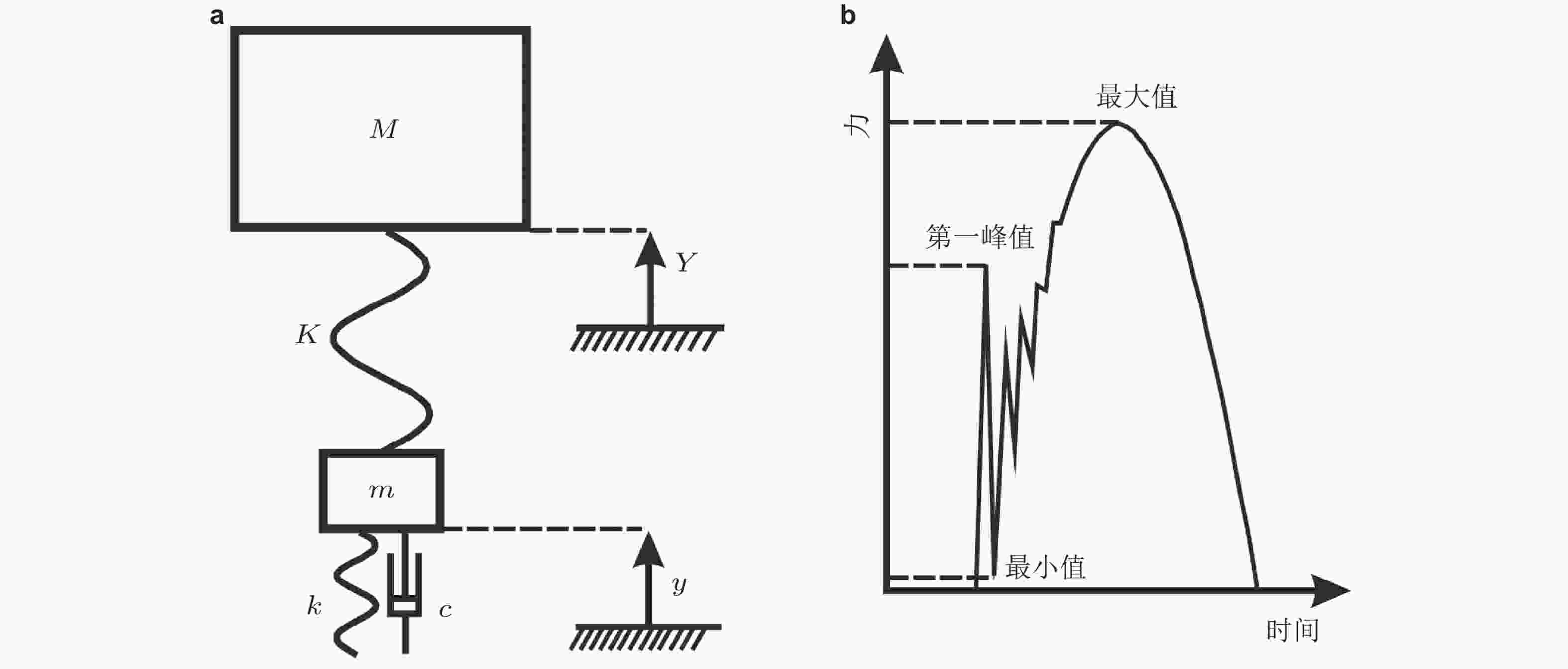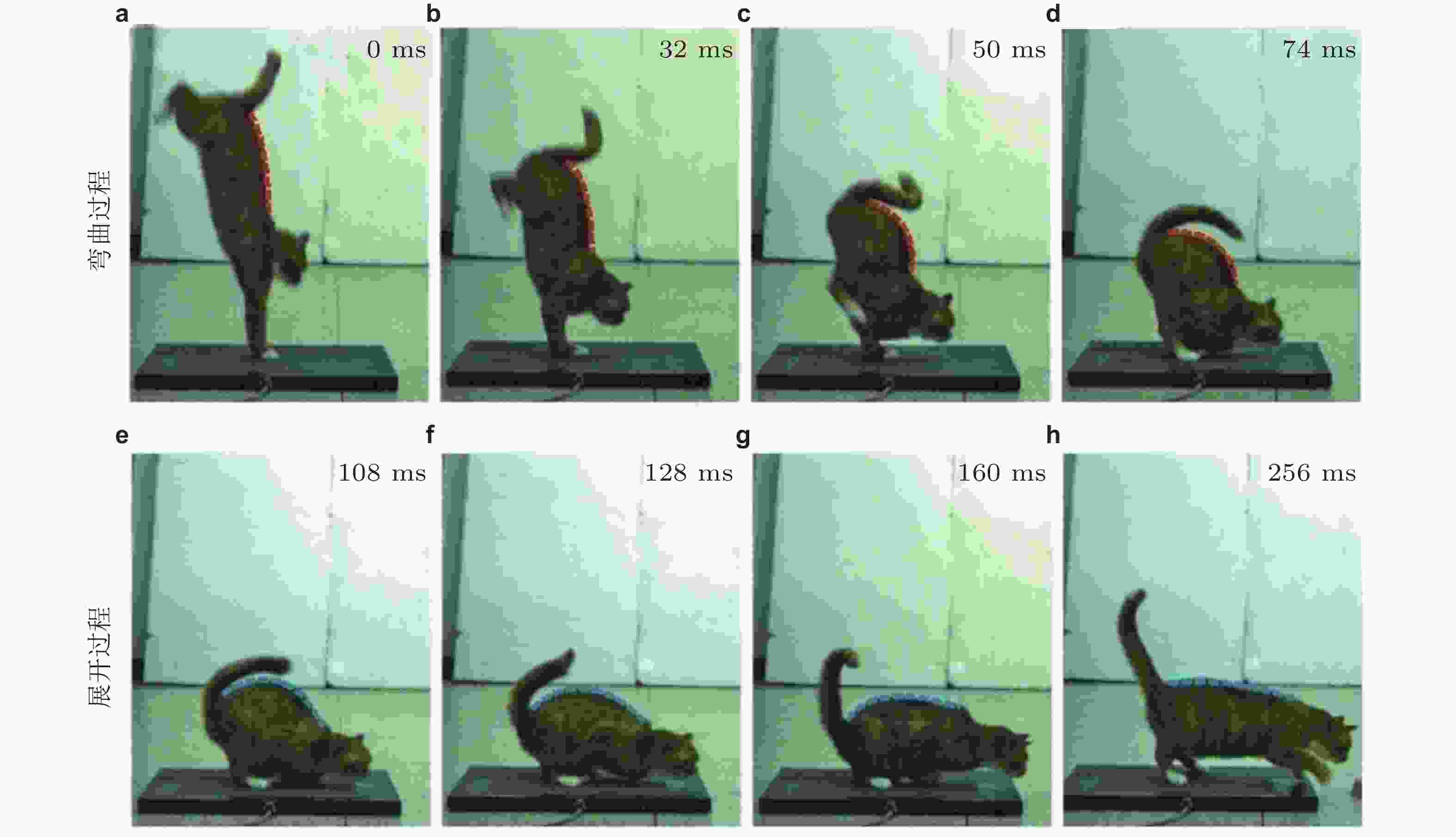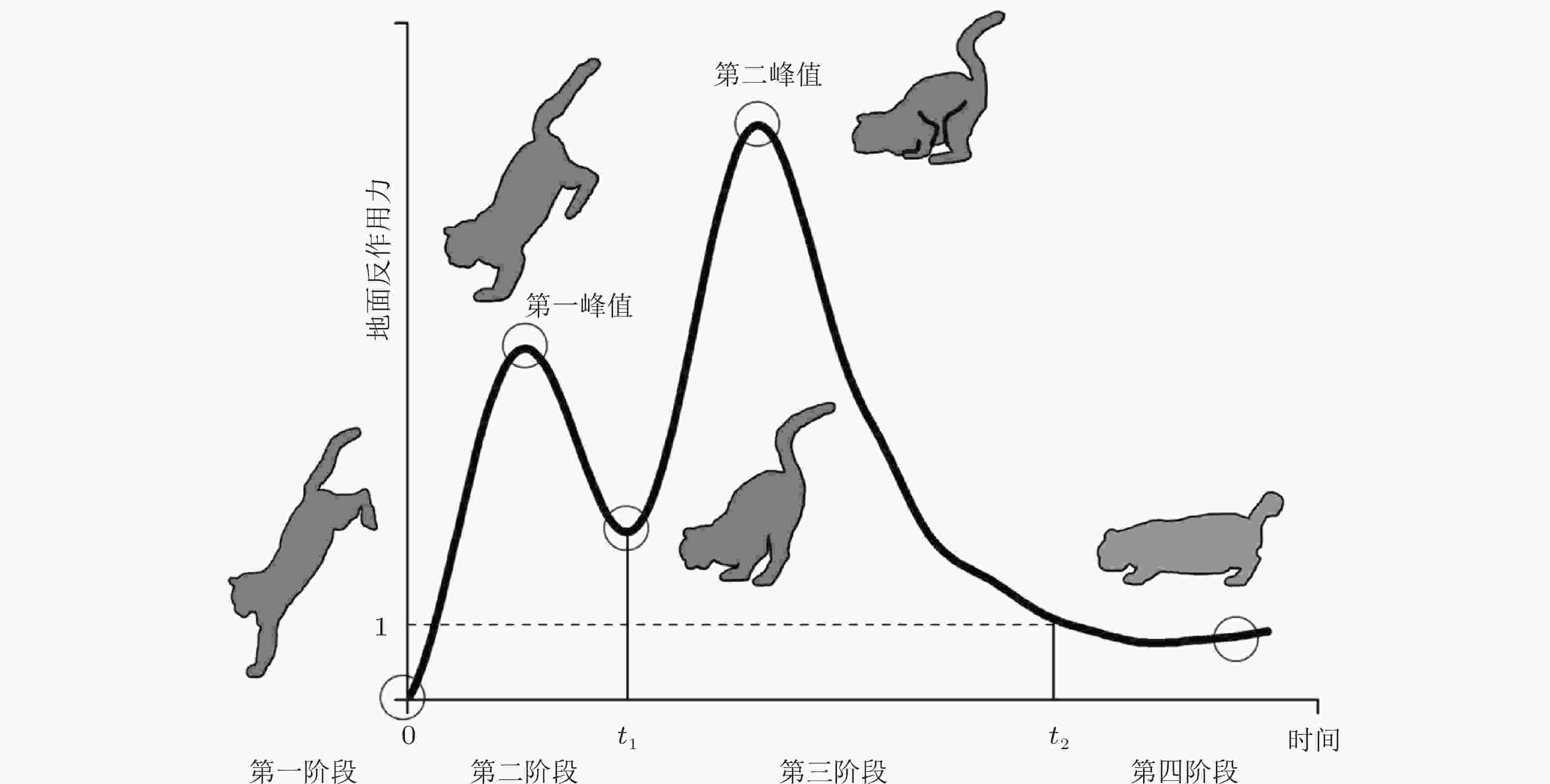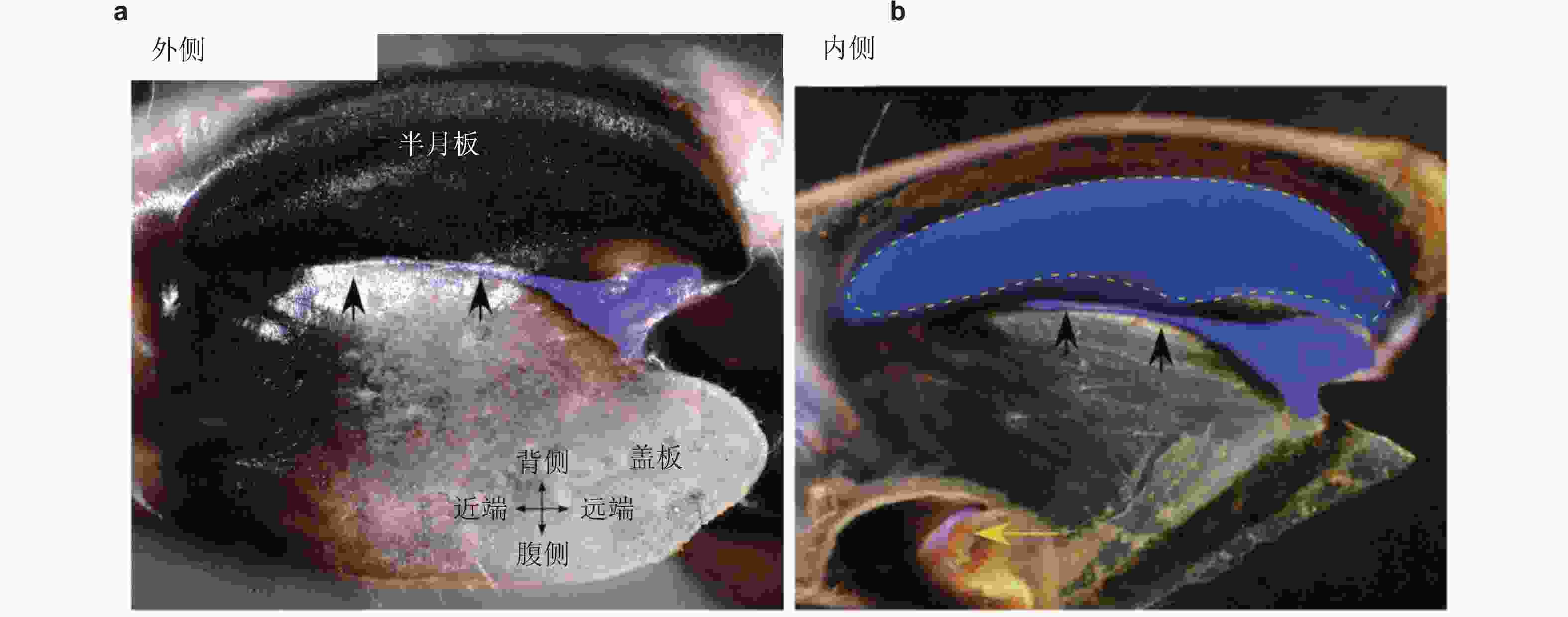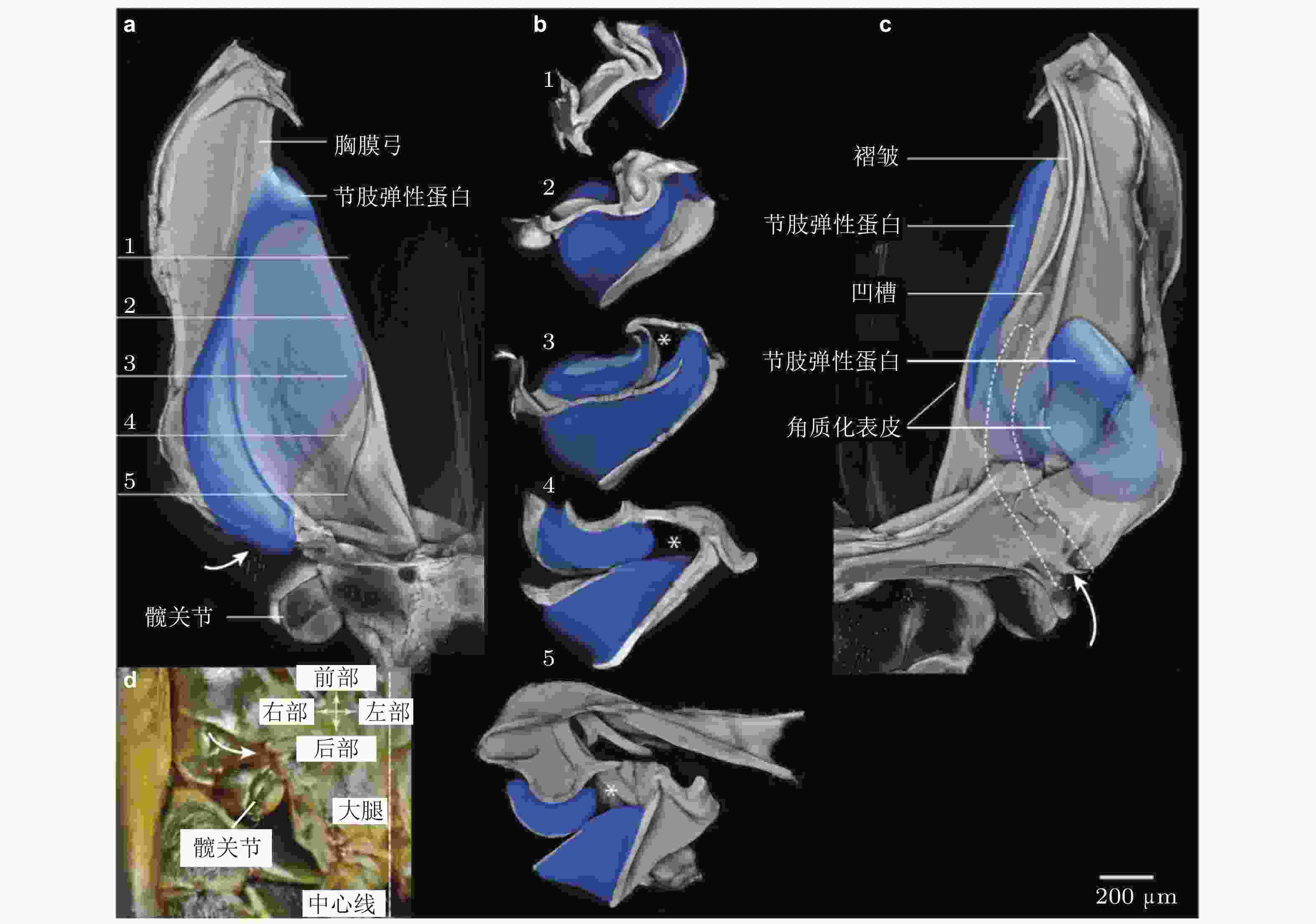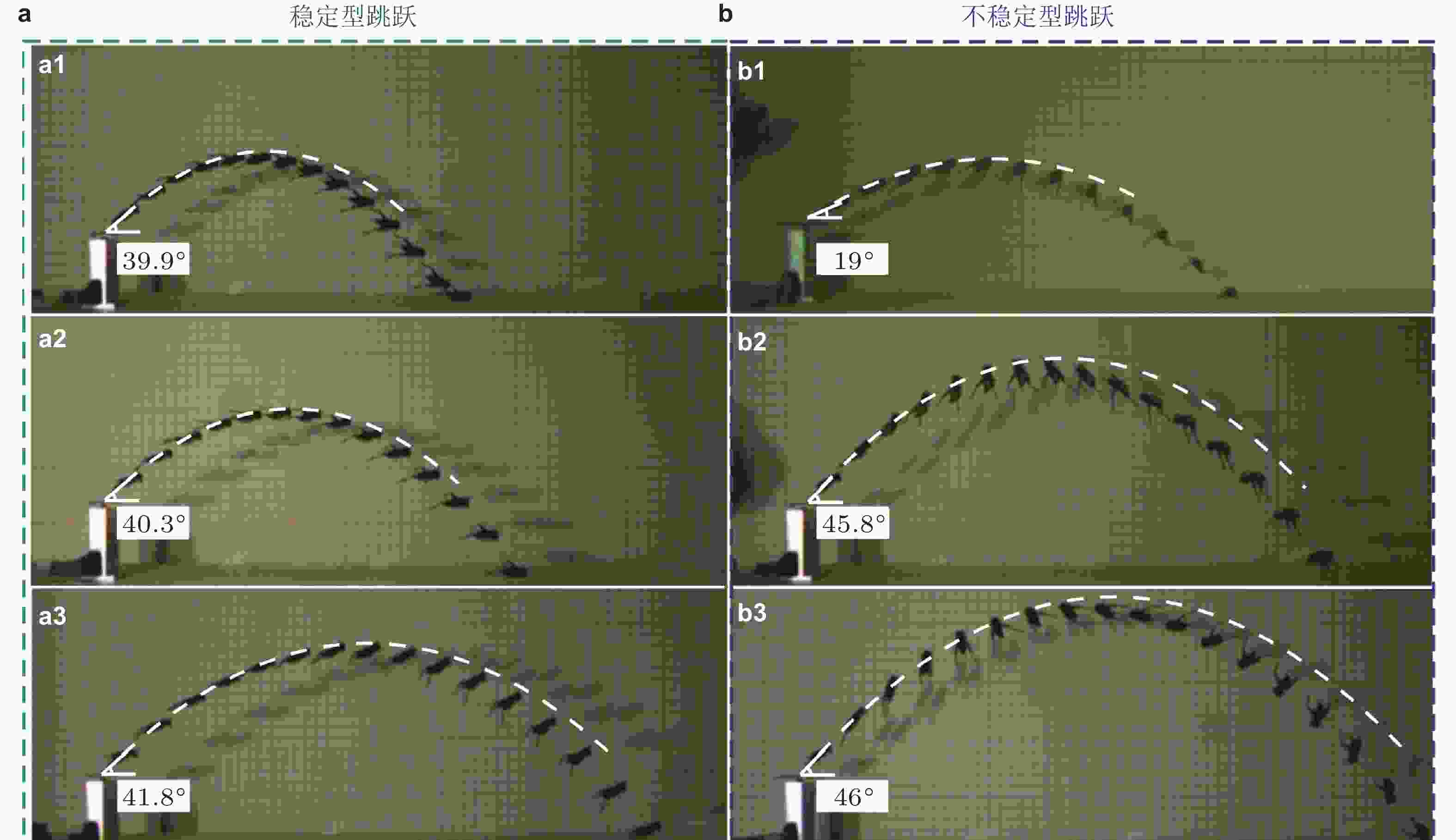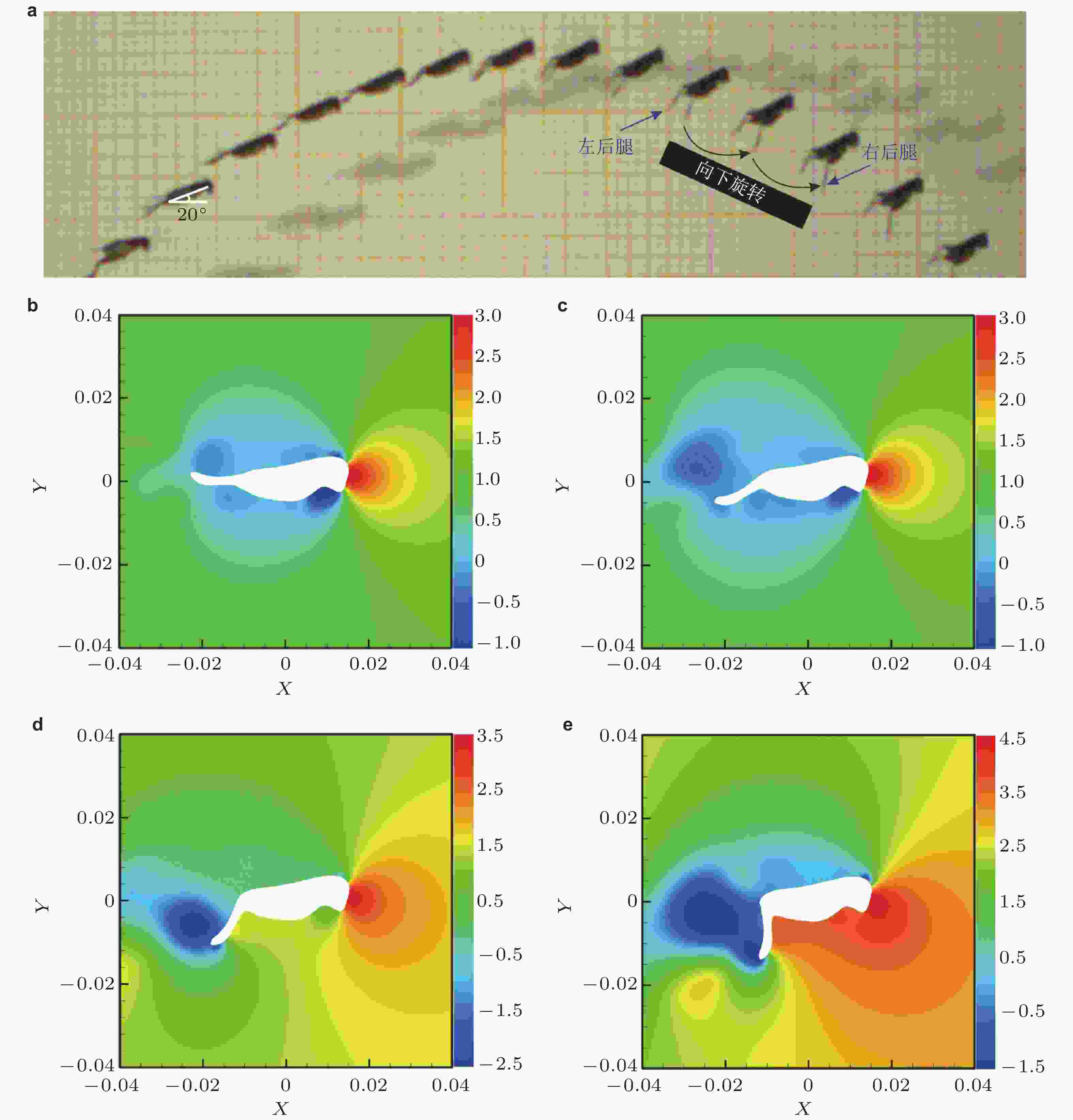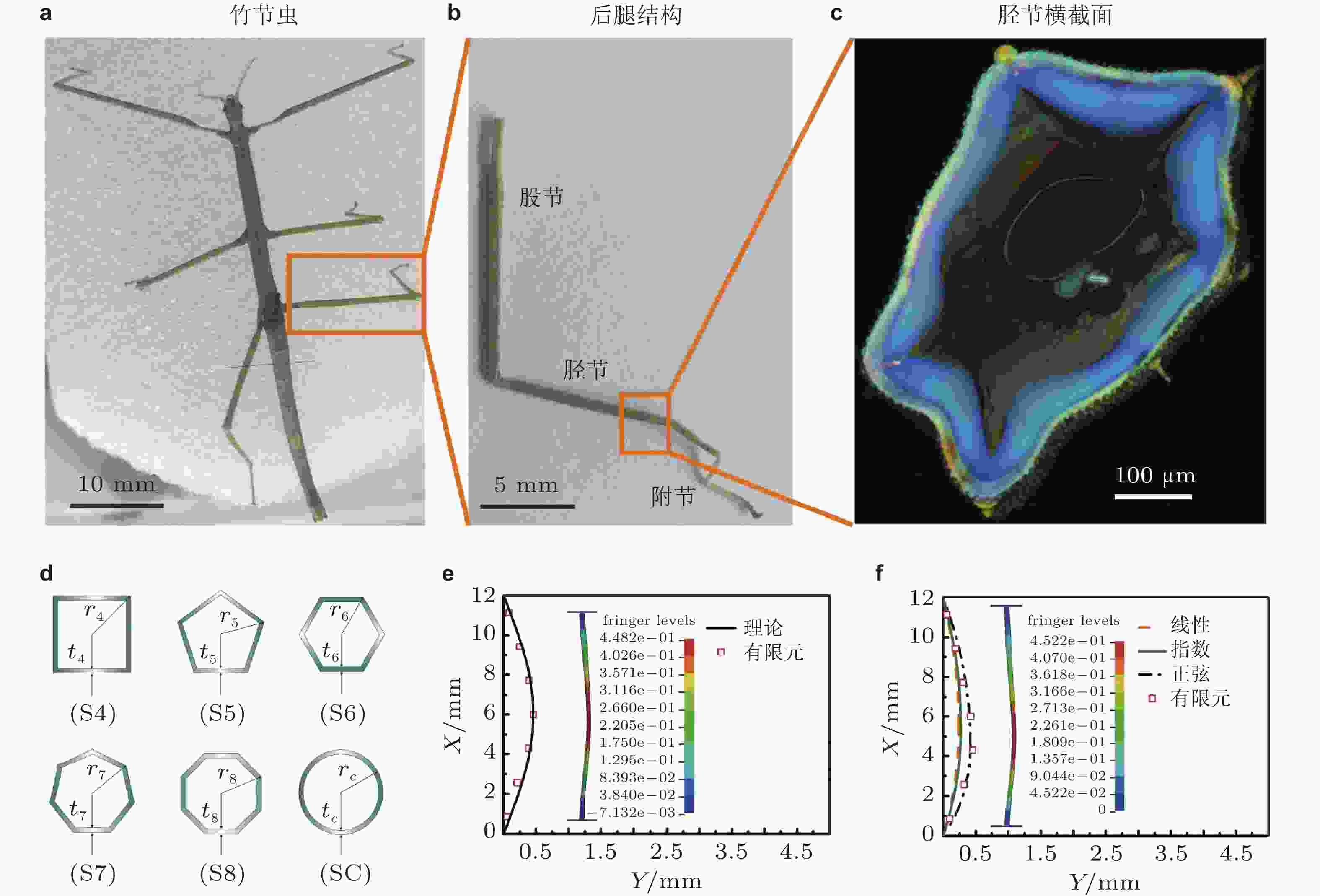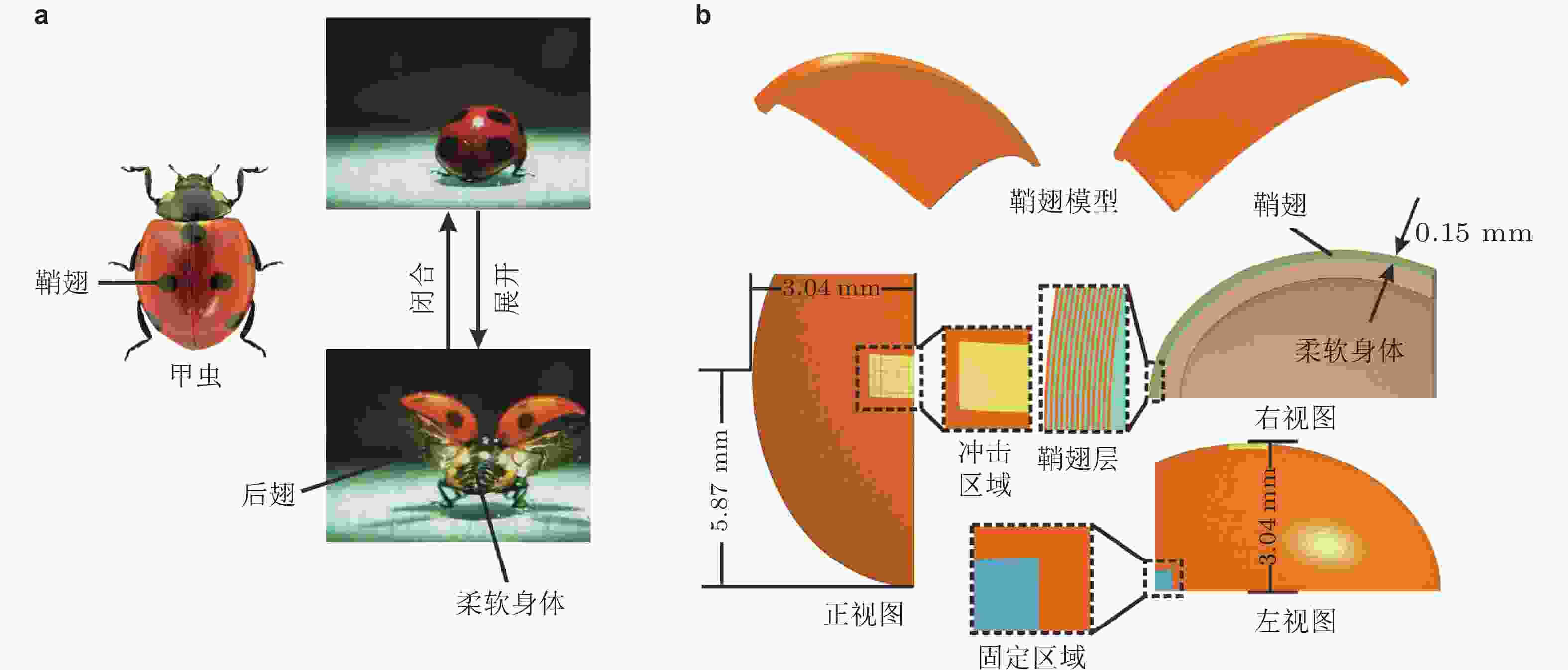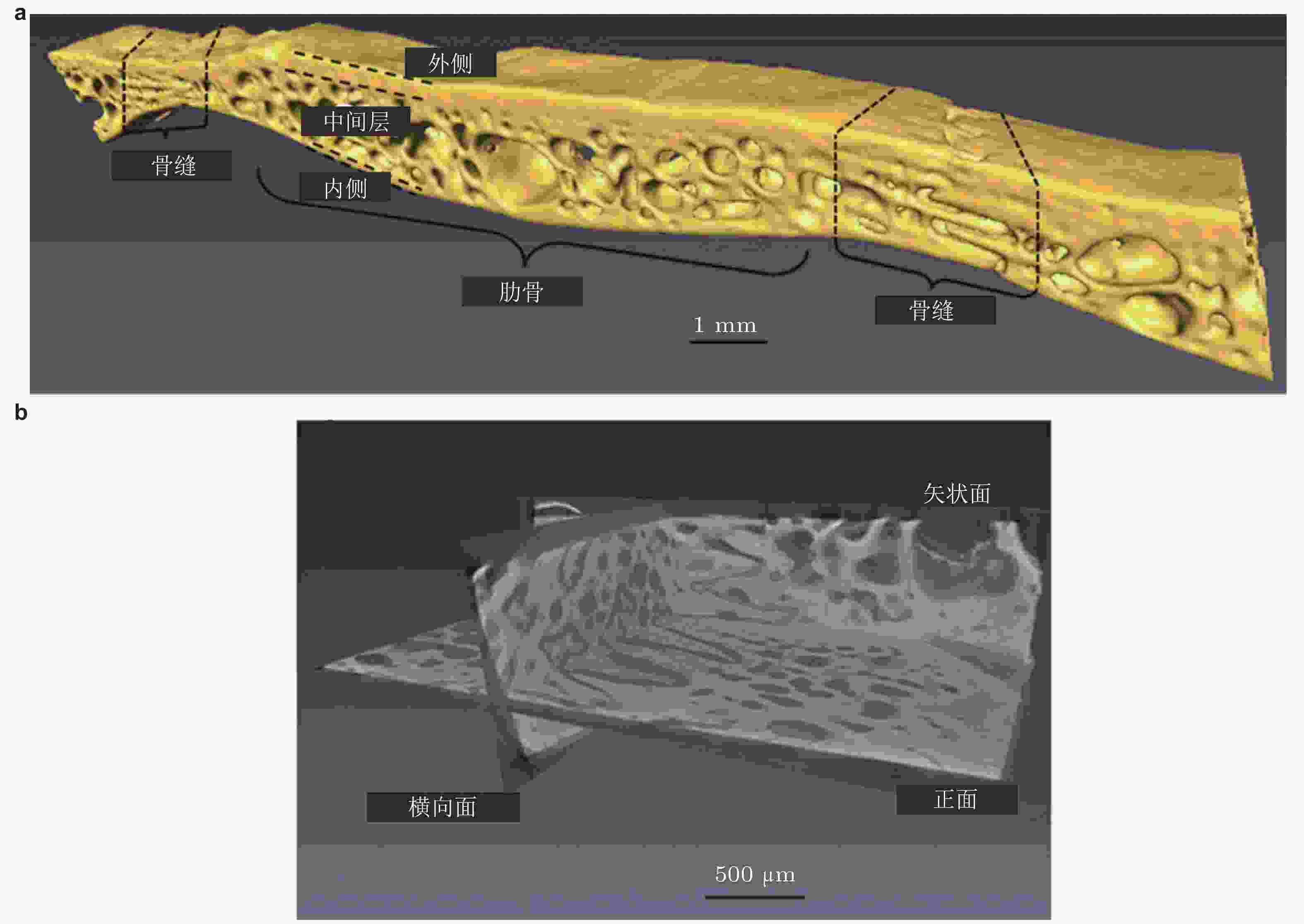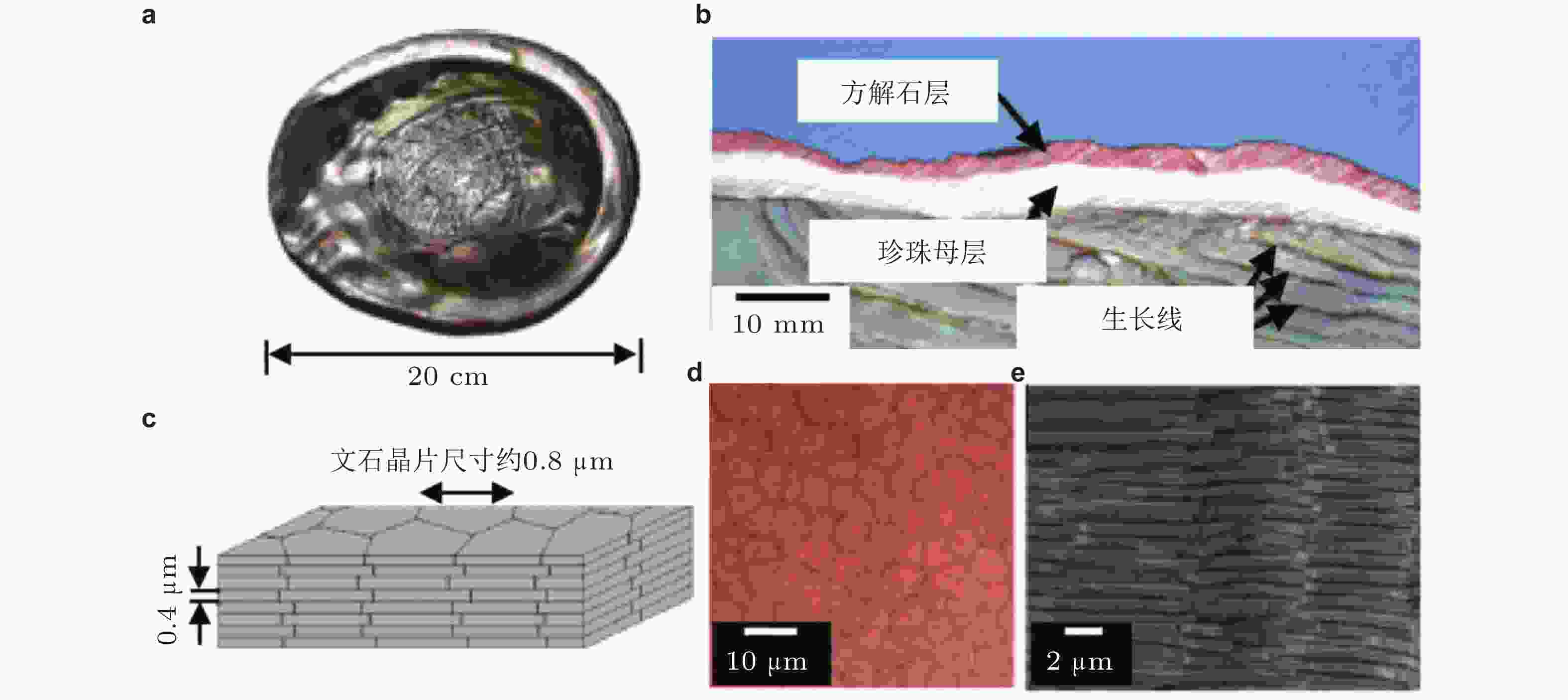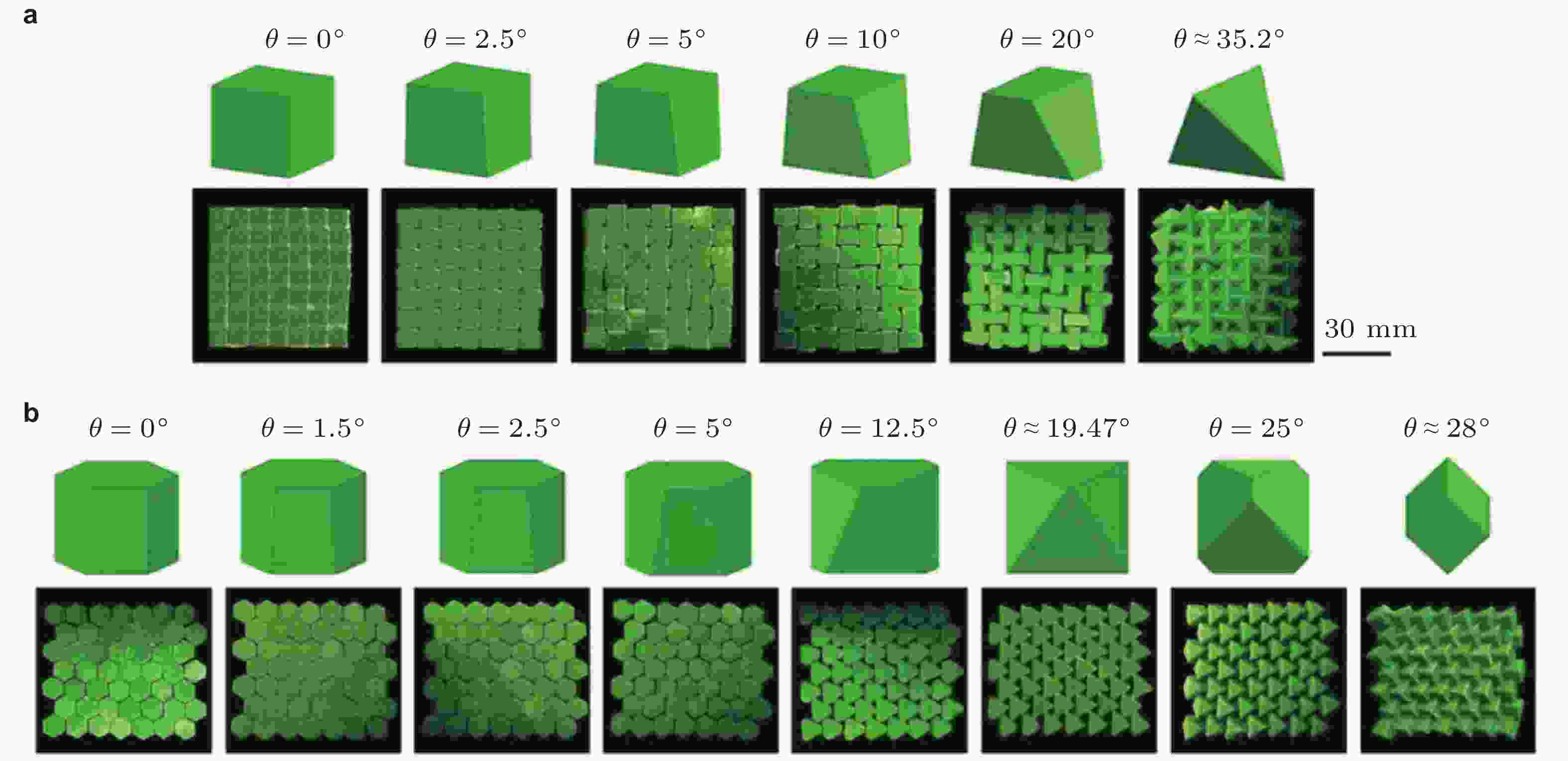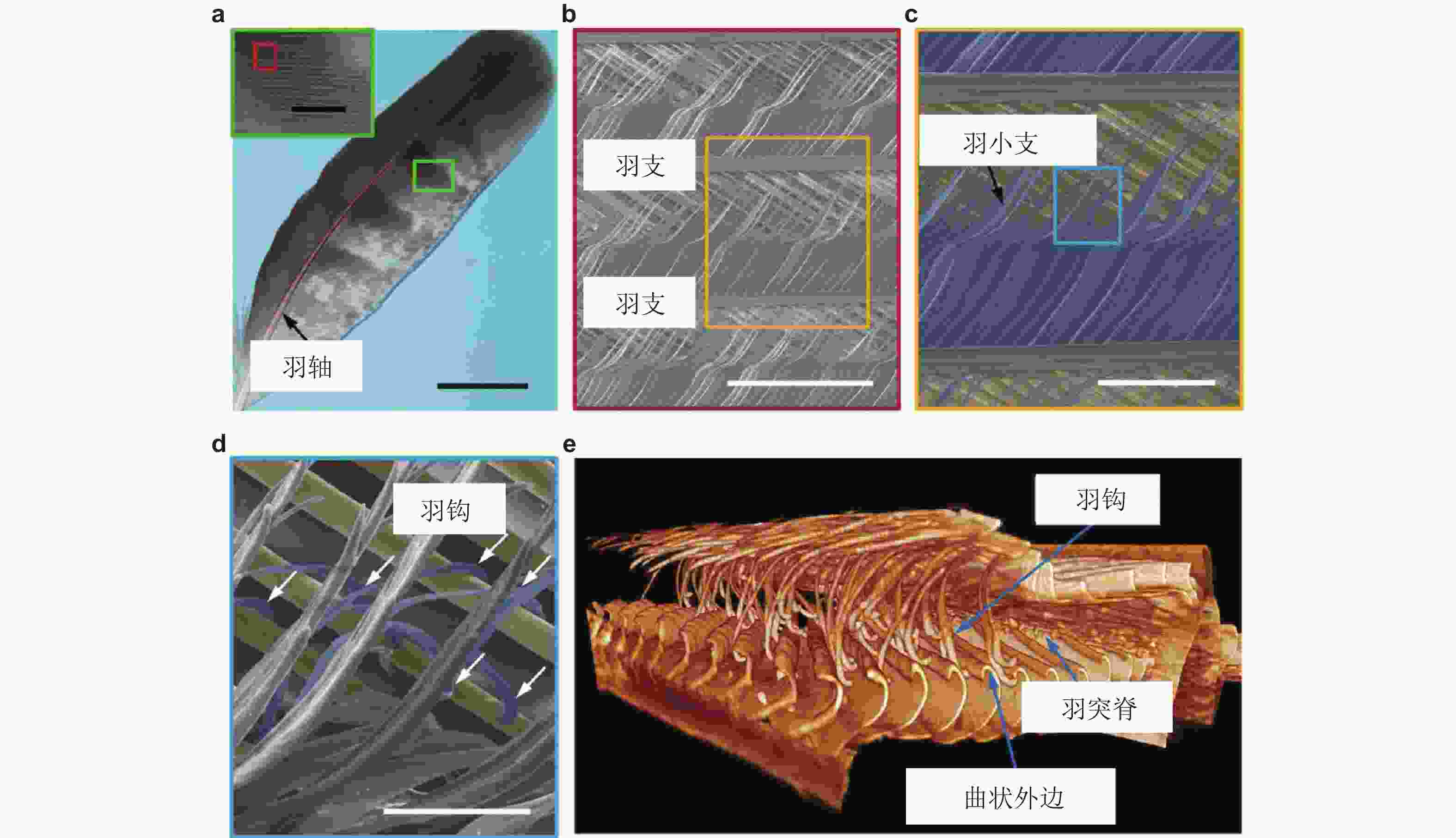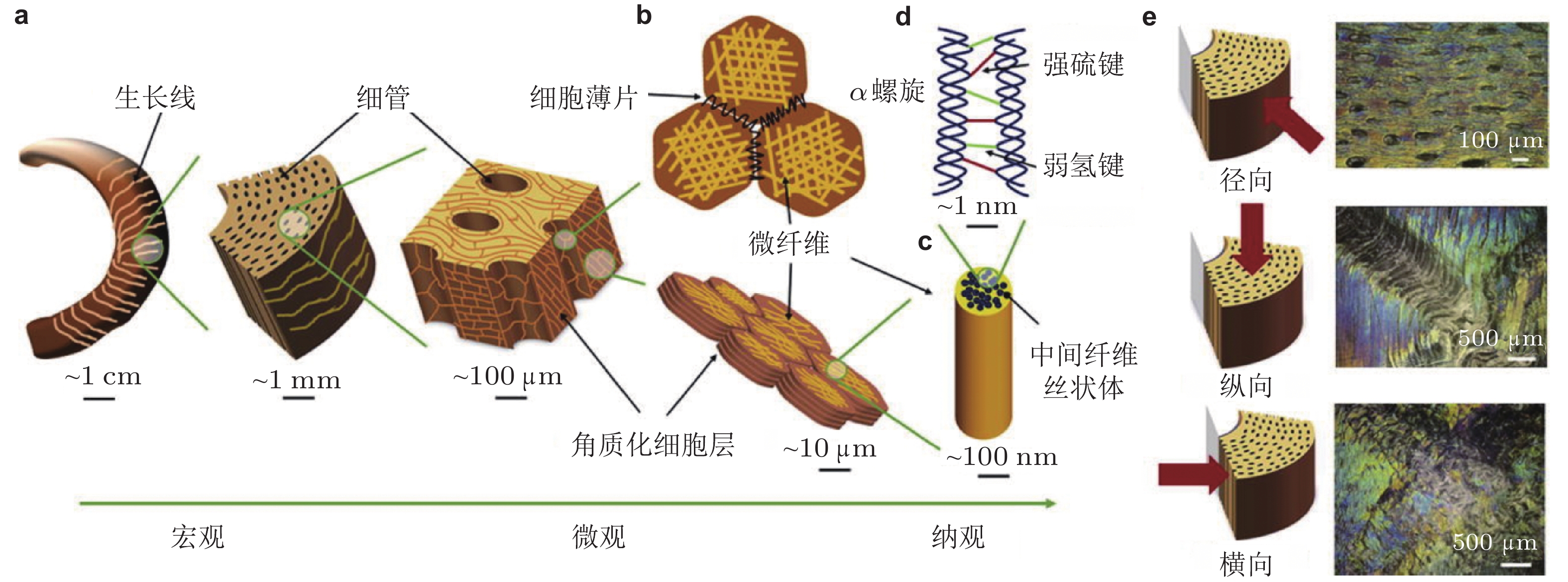Research progress of impact-resistance strategies and biomimetic mechanism in animal evolution
-
摘要: 经过长期的自然选择, 自然界中的动物已经进化出各种各样高效的、可靠的、适应性强的抗冲击策略和机体防护机制, 抵抗来自周围复杂环境的碰撞和冲击载荷, 保护生物外部结构和内部器官在进行激烈生物活动时不受伤害. 相比传统工程防护结构, 这些天然的生物防御系统具有优异的抗冲击特性、高效的能量耗散效率以及可重复使用等特征. 因此, 近年来, 关于探索生物及其仿生机理的研究越来越受到广大学者的关注. 本文作者结合近期在该领域的研究成果, 综述了自然界各类动物的抗冲击策略与身体防护机制及其相关仿生设计与应用的最新研究进展. 特别地, 我们归纳分析和讨论了面对不同载荷环境时生物抗冲击结构独特的进化过程和非凡的力学性能, 并且介绍了相关的抗冲击仿生应用研究. 最后, 讨论了动物抗冲击策略与防护机制及其仿生应用研究的挑战和未来发展方向. 本文可为研究人员和工程师提供有效的数据资料, 为可重复使用能量吸收装置及其飞行器结构的抗冲击与防护设计提供有益借鉴和仿生依据.Abstract: After a long period of natural selection, animals in nature have evolved a variety of efficient, reliable, and adaptable impact-resistance strategies and body-protective mechanisms to resist impact loads from the complex environment they live in, protecting the organisms from injury when they carry out the intense biological activities. These naturally biological defensive systems are characterized by superiorly impact-resistance tolerance, highly energy-dissipated efficiency, and reusability compared to the traditional protective structures used in engineering. In recent years, more and more researchers have paid attention to the study on biomechanical behavior and biomimetic mechanism of organisms in resisting impact loading. In this paper, combining the recent studies in this field, we reviewed the latest research progress in impact-resistance strategies and body-protective mechanisms of various animals in nature and related bio-inspired designs and engineering applications. In particular, we summarized and discussed the unique evolutionary process and extraordinary mechanical properties of biological impact-resistant structures under different loading environments and introduced the related investigations on the biomimetic applications in resisting impact loads. Finally, we analyzed the challenges and developments of the research on impact-resistance strategies and biomimetic mechanisms in animal evolution. This review provides practical data for researchers and engineers and offers a useful reference and bionic basis for the impact-resistance and protective designs of reusable energy absorption devices and aircraft structures.
-
Key words:
- animal /
- impact-resistance strategy /
- protective mechanism /
- bionic /
- energy dissipation
-
图 1 大角羊角部的多级结构. (a) 在宏观尺度发现, 具有生长线的弯曲角整体结构和羊角椭圆形管状结构局部放大图; (b) 在微观尺度发现, 羊角结构由角质化细胞薄片一层一层堆叠而成, 角质化细胞呈扁平饼状, 直径约20 ~ 30 μm, 厚度约 1 ~ 2 μm; (c) 在纳观尺度发现, 在羊角角质化细胞平面内随机分布着直径约为200 nm的纤维结构, 这些纤维结构由更细的纤维细丝(直径约为12 nm)组成; (d) 在分子尺度发现, 以上提及的纤维细丝呈
$ \alpha $ 螺旋状, 由二硫键和氢键相互连接在一起; (e) 羊角3个方向分别受到30%压缩量的准静态压力时, 在羊角的纵向和横向表面内均出现了不同形状的剪切带 (Huang et al. 2017)图 2 马蹄墙的抗冲击结构 (Huang et al. 2019). (a) 新鲜马蹄近端到远端的背侧示意图; (b) 马蹄正中矢状面; (c) 除正中矢状面外的马蹄墙横截面. 定义了3个方向: 纵向(近端到远端); 径向(轴向到背面); 横向方向(在横断面上与蹄壁周长相切); (d) 马蹄墙和内部小管的三维重建同步X射线显微计算机断层扫描图像
图 3 猫旋运动与弯脊柱理论 (Kane and Scher 1969)
图 4 哺乳动物脚掌肉垫着陆理论分析. (a) 弹簧质量阻尼模型, (b) 着陆地面反力曲线 (Alexander et al. 1986)
图 5 家猫着陆过程中背部弯曲–展开的典型运动姿态 (Zhang et al. 2014a). (a) ~ (d)家猫着陆背部弯曲过程. (a)家猫在前肢触地初始时刻其背部呈完全伸展状态; (b)(c)随后家猫背部不断弯曲缩短进行能量储存; (d)当家猫后肢触地时, 其背部的弯曲程度达到最大; (e) ~ (h) 家猫着陆背部展开过程. 着陆后, 家猫的后肢开始压缩缓冲. (e)背部则保持弯曲状态; (f)随着后肢缓冲吸能的结束, 家猫的身体发生反弹, 弯曲的背部开始展开; (g)(h)缓冲结束后, 家猫前后肢分离, 其背部随着身体的向前运动逐渐展开, 背部储存的能量得到释放
图 6 东北虎着陆过程中背部弯曲–展开的典型运动姿态 (于晖 2016). (a) 空中展开阶段; (b) 前腿着陆阶段; (c) 空中转体和后腿着陆阶段, 此阶段背部弯曲变形以吸收能量; (d) 前后腿分离恢复阶段
图 7 家猫着陆四个阶段与地面反力的关系(前后肢分别触地造成地面的双峰现象)(Zhang et al. 2014b)
图 8 基于猫科动物着陆仿生原理的新型航天座椅结构设计 (Yu et al. 2015b). (a) 猫科动物多级缓冲方式的仿生启发, (b) 仿生多级缓冲座椅力学模型
图 9 袋鼠跳跃力学模型 (Alexander 1988)
图 10 蝗虫的储能结构 (Burrows and Sutton 2012). (a) 蝗虫后腿膝关节外侧面(黑色区域为半月板, 蓝色区域为节肢弹性蛋白); (b) 蝗虫后腿膝关节内侧面
图 11 沫蝉的储能结构 (Siwanowicz and Burrows 2017). (a) 沫蝉右胸膜弓内侧视图, (b) 对应图(a)中的5个横截面, (c) 沫蝉右胸膜弓外侧视图, (d) 沫蝉后胸右侧腹面图像
图 12 中华斗蟀的跳跃策略实验分析 (Xing and Yang 2020a). (a) 稳定型跳跃方式, 起跳角分别为: (a1) 39.9°, (a2) 40.3°和(a3) 41.8°; (b) 不稳定型跳跃方式, 起跳角分别为: (b1) 19°, (b2) 45.8°和(b3) 46°
图 13 中华斗蟀增阻抗冲击策略 (Xing and Yang 2020a). (a) 中华斗蟀后腿增阻及其姿态调控实验分析; (b) ~ (e) 后腿与身体的夹角对压强分布的影响, 夹角分别为: (b) −15°, (c) 15°, (d) 45°和(e) 75°
图 14 竹节虫后腿的抗屈曲策略研究 (Xing and Yang 2019). (a) 竹节虫, (b) 竹节虫后腿结构, (c) 竹节虫胫骨横截面的共聚焦激光扫描显微图像, (d) 不同多边形横截面示意图, (e)等梯度胫骨发生欧拉屈曲时的理论预测与数值模拟挠度曲线比较, (f) 不同梯度胫骨发生欧拉屈曲时的理论预测与数值模拟挠度曲线比较
图 15 甲虫鞘翅的抗冲击策略研究 (Xing and Yang 2020b). (a) 甲虫及其鞘翅展开与闭合状态, (b) 甲虫鞘翅的三维几何模型及其抗冲击性能的数值模拟示意图
图 16 不同刚度梯度的甲壳角质层对昆虫鞘翅的防护性能的影响 (Xing and Yang 2020b). (a) 内部软化角质层受压应力云图, (b) 内部硬化角质层受压应力云图, (c) 图(a)和图(b)所示鞘翅模型在准静态载荷下的力位移曲线, (d) 图(a)和图(b)所示鞘翅模型在冲击载荷下的力位移曲线. 红色实线表示内部软化鞘翅角质层, 蓝色实线表示内部硬化鞘翅角质层
图 17 蜘蛛网抗冲击特性分析 (Sensenig et al. 2012). (a) 真实蜘蛛网拦阻实验, (b) 拦阻过程网内丝线能量耗散云图
图 18 乌龟甲壳结构示意图 (Dunlop et al. 2011)
图 19 乌龟甲壳骨缝的微观结构 (Krauss et al. 2009). (a) 龟壳的Micro-CT重构模型, (b) 骨缝区域在3个平面的横截面(正中矢状面, 正面和横向面)
图 20 贝壳多尺度下的分级结构 (Meyers et al. 2008). (a) 整体壳结构, (b) 宏观尺度下的分层结构, (c) 微米尺度下的“砖块–灰浆”结构, (d) 细胞平面内文石晶片结构, (e) 厚度平面内文石晶片结构
图 21 鱼鳞护甲的多级分层结构 (Yang et al. 2012). (a) 巨滑舌鱼鳞片护甲多级分层结构(包含矿物层和胶原纤维层), (b) 短吻鳄鳞片护甲多级分层结构(包含硬磷质层和矿化胶原纤维层)
图 22 鱼鳞的变形与重叠抗冲击策略 (Vernerey and Barthelat 2014). (a) 单个鳞片结构, (b) 鳞片重叠结构, (c) 鳞片结构在整体的分布, (d) 在弯曲过程中鳞片重叠结构的变形
图 23 仿鳄鱼皮自锁抗冲击材料 (Mirkhalaf et al. 2018). (a) 基于正方形中间截面的截短四面体自锁瓦块单体结构, (b) 基于六边形中间截面的截短八面体自锁瓦块单体结构
图 24 雀尾螳螂虾掠食前附肢(趾肢)抗冲击结构 (Yaraghi et al. 2016). (a) 雀尾螳螂虾(掠食前附肢用黄色圆圈标注); (b) 图(a)黄色圆圈标注的雀尾螳螂虾掠食前附肢结构; (c) 掠食前附肢正中矢状面CT扫描图; (d) 图(c)中标记区域的高倍微分干涉对比图像, 突出显示了受撞击表面和周期性受撞击区域; (e) 图(d)中受撞击区域的高倍微分干涉对比图像; (f) 受撞击区域(e)的高分辨率纳米压痕图, 显示了与在受撞击区域内观察到的人字形图案分布相关联的弹性模量振荡
图 25 仿雀尾螳螂虾双正弦波纹状(DSC)夹芯板结构及其力学测试 (Yang et al. 2017). (a) 雀尾螳螂虾, (b) 雀尾螳螂虾仿生双正弦波纹板, (c) 仿生双正弦波纹夹芯板结构, (d) 仿生双正弦波纹板在压缩载荷下的变形模式, (e) 双正弦波纹夹芯板的能量吸收特性比较, (f) 三类波纹夹芯板结构的压缩力位移曲线比较, (g) 双正弦波纹夹芯板的比吸能云图
图 26 羽毛的层级结构 (Zhang et al. 2018). (a) 羽毛叶片由许多侧分支组成, 这些分支平行排列, 相对于主轴成约
$30 ^\circ $ 的角度, 初级侧枝称为倒钩; (b) 相邻的倒钩紧密重叠, 形成致密的羽毛叶片, 在倒钩的两侧出现了二阶侧枝; (c)和(d) 来自一个倒钩的钩子钩住相邻的倒钩并固定羽毛叶片; (e) 小钩钩住相邻倒钩上小叶的弯曲边缘, 可以观察到更细的齿状脊柱立体结构图 27 三种鸟类的波纹状骨缝结构 (Lee et al. 2014). (a) 啄木鸟, (b) 白羽鸡, (c) 犀鸟
表 1 文章内容总览表
1 引言 2.9 蜘蛛网的抗冲击策略 2 陆地动物 3 水中动物 2.1 大象、犀牛、河马等大型动物的身体防护机制 3.1 龟类甲壳的抗冲击策略 2.2 牛科动物角部的抗冲击特性 3.2 软体动物外壳的抗冲击策略 2.3 马蹄墙的抗冲击特性 3.3 鱼鳞的抗冲击策略 2.4 猫科动物的抗冲击策略 3.4 螳螂虾外壳的抗冲击策略 2.5 袋鼠的抗冲击策略 4 空中飞行动物(以鸟类为例)的抗冲击策略 2.6 跳跃昆虫中常见的抗冲击策略 4.1 鸟类羽毛及喙部的抗冲击策略 2.7 竹节虫胫骨的抗冲击策略 5 结论与展望 2.8 甲壳虫鞘翅角质层的抗冲击策略 -
[1] 柴辉, 李建华, 葛文杰. 2009. 基于可调齿轮-五杆机构的仿袋鼠跳跃机器人运动步态分析. 机器人, 31: 487-492 (Chai H, Li J H, Ge W J. 2009. Gait analysis on bionic kangaroo-hopping robot based on adjustable geared five-linkage mechanism. Robot, 31: 487-492). doi: 10.3321/j.issn:1002-0446.2009.06.002 [2] 刘延柱. 1982. 自由下落猫的转体运动. 力学学报, 4: 388-393 (Liu Y Z. 1982. On the turning motion of a free-falling cat. Chinese Journal of Theoretical and Applied Mechanics, 4: 388-393). [3] 王国彪, 陈殿生, 陈科位, 张自强. 2015. 仿生机器人研究现状与发展趋势. 机械工程学报, 51: 27-44 (Wang G B, Chen D S, Chen K W, Zhang Z Q. 2015. The current research status and development strategy on biomimetic robot. Journal of Mechanical Engineering, 51: 27-44). [4] 于晖. 2016. 基于仿生原理的新型缓冲与能量吸收装置的研究. 北京: 北京航空航天大学. [5] 张铭, 葛文杰, 柏龙, 陈晓红. 2009. 星面探测仿生弹跳机器人设计、仿真及实验. 机器人, 31: 481-486 (Zhang M, Ge W J, Bai L, Chen X H. 2009. Design, simulation and experiment of a bionic hopper for planet exploration. Robot, 31: 481-486). doi: 10.3321/j.issn:1002-0446.2009.06.001 [6] 张晓鹏, 杨嘉陵, 于晖. 2012. 猫科动物脚掌肉垫缓冲力学特性分析. 生物医学工程学杂志, 29: 1098-1104 (Zhang X P, Yang J L, Yu H. 2012. Mechanical buffering characteristics of feline paw pads. Journal of Biomedical Engineering, 29: 1098-1104). [7] 郑秀瑗. 2002. 现代运动生物力学. 北京: 国防工业出版社Zheng X Y. 2002. Modern Sports Biomechanics. Beijing: National Defense Industry Press [8] 钟奉俄. 1985. 关于自由下落猫的双刚体模型. 力学学报, 17: 72-77 (Zhong F E. 1985. A two-rigid-body model of the free-falling cat. Chinese Journal of Theoretical and Applied Mechanics, 17: 72-77). [9] Achrai B, Bar-On B, Wagner H D. 2014. Bending mechanics of the red-eared slider turtle carapace. Journal of the Mechanical Behavior of Biomedical Materials, 30: 223-233. doi: 10.1016/j.jmbbm.2013.09.009 [10] Achrai B, Bar-On B, Wagner H D. 2015. Biological armors under impact-effect of keratin coating, and synthetic bio-inspired analogues. Bioinspiration & Biomimetics, 10: 016009. [11] Achrai B, Wagner H D. 2013. Micro-structure and mechanical properties of the turtle carapace as a biological composite shield. Acta Biomaterialia, 9: 5890-5902. doi: 10.1016/j.actbio.2012.12.023 [12] Achrai B, Wagner H D. 2015. The red-eared slider turtle carapace under fatigue loading: The effect of rib-suture arrangement. Materials Science and Engineering: C, 53: 128-133. doi: 10.1016/j.msec.2015.04.040 [13] Alam M S. 2005. Damage tolerance in naturally compliant structures. International Journal of Damage Mechanics, 14: 365-384. doi: 10.1177/1056789505054313 [14] Alam M S, Wahab M A, Jenkins C H. 2007. Mechanics in naturally compliant structures. Mechanics of Materials, 39: 145-160. doi: 10.1016/j.mechmat.2006.04.005 [15] Alexander R M. 1976. Estimates of speeds of dinosaurs. Nature, 261: 129-130. doi: 10.1038/261129a0 [16] Alexander R M. 1988. Elastic Mechanisms in Animal Movement. Cambridge: Cambridge University Press [17] Alexander R M. 2003. Principles of Animal Locomotion. Princeton: Princeton University Press [18] Alexander R M, Bennett M B, Ker R F. 1986. Mechanical properties and function of the paw pads of some mammals. Journal of Zoology, 209: 405-419. doi: 10.1111/j.1469-7998.1986.tb03601.x [19] Alexander R M, Jayes A S. 1983. A dynamic similarity hypothesis for the gaits of quadrupedal mammals. Journal of Zoology, 201: 135-152. [20] Alexander R M, Vernon A. 1971. The mechanics of hopping by kangaroos (Macropodidae). Proceedings of the Zoological Society of London, 177: 265-303. [21] Andersen S O. 1979. Biochemistry of Insect Cuticle. Annual Review of Entomology, 24: 29-59. doi: 10.1146/annurev.en.24.010179.000333 [22] Appel E, Heepe L, Lin C P, Gorb S N. 2015. Ultrastructure of dragonfly wing veins: Composite structure of fibrous material supplemented by resilin. Journal of Anatomy, 227: 561-582. doi: 10.1111/joa.12362 [23] Bai L, Ge W, Chen X, Tang Q, Xiang R. 2015. Landing impact analysis of a bioinspired intermittent hopping robot with consideration of friction. Mathematical Problems in Engineering, 2: 1-12. [24] Balani K, Patel R R, Keshri A K, Lahiri D, Agarwal A. 2011. Multi-scale hierarchy of chelydra serpentina: microstructure and mechanical properties of turtle shell. Journal of the Mechanical Behavior of Biomedical Materials, 4: 1440-1451. doi: 10.1016/j.jmbbm.2011.05.014 [25] Barbakadze N, Enders S, Gorb S, Arzt E. 2006. Local mechanical properties of the head articulation cuticle in the beetle Pachnoda marginata (Coleoptera, Scarabaeidae). Journal of Experimental Biology, 209: 722-730. doi: 10.1242/jeb.02065 [26] Beer F P, Johnston E R, Dewolf J T, Mazurek D F. 2012. Mechanics of Materials. McGraw-Hill [27] Bennet-Clark H C. 1975. The energetics of the jump of the locust Schistocerca gregaria. Journal of Experimental Biology, 63: 53-83. [28] Bertram J E A, Gosline J M. 1986. Fracture-toughness design in horse hoof keratin. Journal of Experimental Biology, 125: 29-47. [29] Burrows M. 2003. Froghopper insects leap to new heights. Nature, 424: 509. doi: 10.1038/424509a [30] Burrows M. 2006a. Jumping performance of froghopper insects. Journal of Experimental Biology, 209: 4607-4621. doi: 10.1242/jeb.02539 [31] Burrows M. 2006b. Morphology and action of the hind leg joints controlling jumping in froghopper insects. Journal of Experimental Biology, 209: 4622-4637. doi: 10.1242/jeb.02554 [32] Burrows M. 2007. Kinematics of jumping in leafhopper insects (Hemiptera, Auchenorrhyncha, Cicadellidae). Journal of Experimental Biology, 210: 3579-3589. doi: 10.1242/jeb.009092 [33] Burrows M. 2009. Jumping performance of planthoppers (Hemiptera, Issidae). Journal of Experimental Biology, 212: 2844-2855. doi: 10.1242/jeb.032326 [34] Burrows M. 2013a. Jumping mechanisms in gum treehopper insects (Hemiptera, Eurymelinae). Journal of Experimental Biology, 216: 2682-2690. doi: 10.1242/jeb.085266 [35] Burrows M. 2013b. Jumping mechanisms of treehopper insects (Hemiptera, Auchenorrhyncha, Membracidae). Journal of Experimental Biology, 216: 788-799. [36] Burrows M. 2014. Jumping mechanisms in dictyopharid planthoppers (Hemiptera, Dicytyopharidae). Journal of Experimental Biology, 217: 402-413. doi: 10.1242/jeb.093476 [37] Burrows M, Cullen D A, Dorosenko M, Sutton G P. 2015. Mantises exchange angular momentum between three rotating body parts to jump precisely to targets. Current Biology, 25: 786-789. doi: 10.1016/j.cub.2015.01.054 [38] Burrows M, Dorosenko M. 2014. Jumping mechanisms in lacewings (Neuroptera, Chrysopidae and Hemerobiidae). Journal of Experimental Biology, 217: 4252-4261. doi: 10.1242/jeb.110841 [39] Burrows M, Dorosenko M. 2015a. Jumping mechanisms and strategies in moths (Lepidoptera). Journal of Experimental Biology, 218: 1655-1666. doi: 10.1242/jeb.120741 [40] Burrows M, Dorosenko M. 2015b. Jumping mechanisms in adult caddis flies (Insecta, Trichoptera). Journal of Experimental Biology, 218: 2764-2774. doi: 10.1242/jeb.123471 [41] Burrows M, Dorosenko M. 2017. Jumping performance of flea hoppers and other mirid bugs (Hemiptera, Miridae). Journal of Experimental Biology, 220: 1606-1617. [42] Burrows M, Morris O. 2002. Jumping in a winged stick insect. Journal of Experimental Biology, 205: 2399-2412. [43] Burrows M, Morris O. 2003. Jumping and kicking in bush crickets. Journal of Experimental Biology, 206: 1035-1049. doi: 10.1242/jeb.00214 [44] Burrows M, Picker M D. 2010. Jumping mechanisms and performance of pygmy mole crickets (Orthoptera, Tridactylidae). Journal of Experimental Biology, 213: 2386-2398. doi: 10.1242/jeb.042192 [45] Burrows M, Sutton G P. 2012. Locusts use a composite of resilin and hard cuticle as an energy store for jumping and kicking. Journal of Experimental Biology, 215: 3501-3512. doi: 10.1242/jeb.071993 [46] Chao W, Hao Z, Feng X. 2016. Structures, properties, and energy-storage mechanisms of the semi-lunar process cuticles in locusts. Scientific Reports, 6: 35219. doi: 10.1038/srep35219 [47] Chen C C, Li D G, Yano H, Abe K. 2019. Insect cuticle-mimetic hydrogels with high mechanical properties achieved via the combination of chitin nanofiber and gelatin. Journal of Agricultural and Food Chemistry, 67: 5571-5578. doi: 10.1021/acs.jafc.9b00984 [48] Chen D, Chen K, Zhang Z, Zhang B. 2015. Mechanism of locust air posture adjustment. Journal of Bionic Engineering, 12: 418-431. doi: 10.1016/S1672-6529(14)60133-5 [49] Chen Y K, Liao C P, Tsai F Y, Chi K J. 2013. More than a safety line: Jump-stabilizing silk of salticids. Journal of the Royal Society Interface, 10: 20130572. doi: 10.1098/rsif.2013.0572 [50] Chintapalli R K, Mirkhalaf M, Dastjerdi A K, Barthelat F. 2014. Fabrication, testing and modeling of a new flexible armor inspired from natural fsh scales and osteoderms. Bioinspiration & Biomimetics, 9: 036005. [51] Cofer D, Cymbalyuk G, Heitler W J, Edwards D H. 2010. Control of tumbling during the locust jump. Journal of Experimental Biology, 213: 3378-3387. doi: 10.1242/jeb.046367 [52] Combes S A, Daniel T L. 2003. Flexural stiffness in insect wings. I. Scaling and the influence of wing venation. Journal of Experimental Biology, 206: 2979-2987. doi: 10.1242/jeb.00523 [53] Craig C L. 2010. The ecological and evolutionary interdependence between web architecture and web silk spun by orb web weaving spiders. Biological Journal of the Linnean Society, 30: 135-162. [54] Crevier N, Robin D, Pourcelot P, Falala S, Holden L, Estoup P, Desquilbet L, Denoix J, Chateau H. 2010. Ground reaction force and kinematic analysis of limb loading on two different beach sand tracks in harness trotters. Equine Veterinary Journal, 42: 544-551. doi: 10.1111/j.2042-3306.2010.00202.x [55] Damiens R, Rhee H, Hwang Y, Park S J, Hammi Y, Lim H, Horstemeyer M F. 2012. Compressive behavior of a turtle's shell: experiment, modeling, and simulation. Journal of the Mechanical Behavior of Biomedical Materials, 6: 106-112. doi: 10.1016/j.jmbbm.2011.10.011 [56] Dawson T J, Taylor C R. 1973. Energetic cost of locomotion. Nature, 246: 313-314. doi: 10.1038/246313a0 [57] Denny M. 1976. The physical properties of spider's silk and their role in design of orb webs. Journal of Experimental Biology, 65: 483-506. [58] DeVita P, Skelly W A. 1992. Effect of landing stiffness on joint kinetics and energetics in the lower extremity. Medicine and Science in Sports and Exercise, 24: 108-115. [59] Diamond J M. 1988. Why cats have nine lives. Nature, 332: 586-587. doi: 10.1038/332586a0 [60] Diamond J M. 1989. How cats survive falls from new york skyscrapers. Natural History, 98: 20-26. [61] Dirks J H, Durr V. 2011. Biomechanics of the stick insect antenna: Damping properties and structural correlates of the cuticle. Journal of the Mechanical Behavior of Biomedical Materials, 4: 2031-2042. doi: 10.1016/j.jmbbm.2011.07.002 [62] Douglas J, Mittal C, Thomason J, Jofriet J. 1996. The modulus of elasticity of equine hoof wall: Implications for the mechanical function of the hoof. Journal of Experimental Biology, 199: 1829-1836. [63] Drake A, Donahue T L H, Stansloski M, Fox K, Wheatley B B, Donahue S W. 2016. Horn and horn core trabecular bone of bighorn sheep rams absorbs impact energy and reduces brain cavity accelerations during high impact ramming of the skull. Acta Biomaterialia, 44: 41-50. doi: 10.1016/j.actbio.2016.08.019 [64] Dunlop J W C, Weinkamer R, Fratzl P. 2011. Artful interfaces within biological materials. Materials Today, 14: 70-78. doi: 10.1016/S1369-7021(11)70056-6 [65] Dutta A, Tekalur S A, Miklavcic M. 2013. Optimal overlap length in staggered architecture composites under dynamic loading conditions. Journal of the Mechanics and Physics of Solids, 61: 145-160. doi: 10.1016/j.jmps.2012.08.005 [66] Dutta A, Vanderklok A, Tekalur S A. 2012. High strain rate mechanical behavior of seashell-mimetic composites: Analytical model formulation and validation. Mechanics of Materials, 55: 102-111. doi: 10.1016/j.mechmat.2012.08.003 [67] Fenn W O. 1930. Frictional and kinetic factors in the work of sprint running. American Journal of Physiology, 93: 433-462. doi: 10.1152/ajplegacy.1930.93.2.433 [68] Fernandes M C, Aizenberg J, Weaver J C, Bertoldi K. 2020. Mechanically robust lattices inspired by deep-sea glass sponges. Nature Materials, 267: 2687. [69] Fernandez J G, Ingber D E. 2012. Unexpected strength and toughness in chitosan-fibroin laminates inspired by insect cuticle. Advanced materials, 24: 480-484. doi: 10.1002/adma.201104051 [70] Feughelman M. 1994. A model for the mechanical properties of the α-keratin cortex. Textile Research Journal, 64: 236-239. doi: 10.1177/004051759406400408 [71] Fish J F, Stayton C T. 2014. Morphological and mechanical changes in juvenile red-eared slider turtle (Trachemys scripta elegans) shells during ontogeny. Journal of Morphology, 275: 391-397. doi: 10.1002/jmor.20222 [72] Fraser R, MacRae T, Miller A. 1964. The coiled-coil model of a-keratin structure. Journal of Molecular Biology, 10: 147-156. doi: 10.1016/S0022-2836(64)80034-6 [73] Fraser R, MacRae T, Suzuki E. 1976. Structure of the a-keratin microfibril. Journal of Molecular Biology, 108: 435-452. doi: 10.1016/S0022-2836(76)80129-5 [74] Fudge D S, Gardner K H, Forsyth V T, Riekel C, Gosline J M. 2003. The mechanical properties of hydrated intermediate filaments: insights from hagfish slime threads. Biophysical Journal, 85: 2015-2027. doi: 10.1016/S0006-3495(03)74629-3 [75] Fudge D S, Gosline J M. 2004. Molecular design of the a-keratin composite: Insights from a matrix-free model, hagfish slime threads. Proceedings of the Royal Society B: Biological Science, 271: 291-299. doi: 10.1098/rspb.2003.2591 [76] Geist V. 1966a. The evolution of horn-like organs. Behaviour, 27: 175-214. doi: 10.1163/156853966X00155 [77] Geist V. 1966b. The evolutionary significance of mountain sheep horns. Evolution; International Journal of Organic Evolution, 20: 558-566. doi: 10.1111/j.1558-5646.1966.tb03386.x [78] Ghara M, Kundanati L, Borges R M. 2011. Nature's Swiss Army Knives: Ovipositor structure mirrors ecology in a multitrophic fig wasp community. PloS One, 6: e23642. doi: 10.1371/journal.pone.0023642 [79] Ghosh R, Ebrahimi H, Vaziri A. 2014. Contact kinematics of biomimetic scales. Applied Physics Letters, 105: 233701. doi: 10.1063/1.4903160 [80] Gibson L J. 2006. Woodpecker pecking: How woodpeckers avoid brain injury. Journal of Zoology, 270: 462-465. doi: 10.1111/j.1469-7998.2006.00166.x [81] Gosline J M, Guerette P A, Ortlepp C S, Savage K N. 1999. The mechanical design of spider silks: From fibroin sequence to mechanical function. Journal of Experimental Biology, 202: 3295-3303. [82] Gosline J M, Lillie M, Carrington E, Guerette P, Ortlepp C, Savage K N. 2002. Elastic proteins: Biological roles and mechanical properties. Philosophical transactions-Royal Society. Biological Sciences, 357: 121-132. doi: 10.1098/rstb.2001.1022 [83] Guarin-Zapata N, Gomez J, Yaraghi N, Kisailus D, Zavattieri P D. 2015. Shear wave filtering in naturally-occurring bouligand structures. Acta Biomaterialia, 23: 11-20. doi: 10.1016/j.actbio.2015.04.039 [84] Guo Y, Chang Z, Li B, Zhao Z L, Zhao H P, Feng X Q, Gao H J. 2018. Functional gradient effects on the energy absorption of spider orb webs. Applied Physics Letters, 113: 103701. doi: 10.1063/1.5039710 [85] Gurdjian E S. 1975. Re-evaluation of the biomechanics of blunt impact injury of the head. Surgery, Gynecology & Obstetrics, 140: 845-850. [86] Guyou M. 1894. Note relative a la Communication de M. Marey (in French). Comptes rendus hebdomadaires des seances del academie des sciences, 119: 717-718. [87] Ha N S, Lu G. 2020. A review of recent research on bio-inspired structures and materials for energy absorption applications. Composites Part B: Engineering, 181: 107496. doi: 10.1016/j.compositesb.2019.107496 [88] Hadley N F. 1986. The arthropod cuticle. Scientific American, 86: 104-112. [89] Hopkins T L, Kramer K J. 1992. Insect cuticle sclerotization. Annual Review of Entomology, 37: 273-302. doi: 10.1146/annurev.en.37.010192.001421 [90] Huang W, Yaraghi N A, Yang W, Velazquez-Olivera A, Li Z Z, Ritchie R O, Kisailus D, Stover S M, McKittrick J. 2019. A natural energy absorbent polymer composite: The equine hoof wall. Acta Biomaterialia, 90: 267-277. doi: 10.1016/j.actbio.2019.04.003 [91] Huang W, Zaheri A, Jung J Y, Espinosa H D, Mckittrick J. 2017. Hierarchical structure and compressive deformation mechanisms of bighorn sheep (Ovis canadensis) horn. Acta Biomaterialia, 64: 1-14. doi: 10.1016/j.actbio.2017.09.043 [92] Huang Z W, Li H Z, Pan Z L, Wei Q M, Chao Y J, Li X D. 2011. Uncovering high-strain rate protection mechanism in nacre. Scientific Reports, 1: 00148. doi: 10.1038/srep00148 [93] Huang Z W, Pan Z L, Li H Z, Wei Q M, Li X D. 2014. Hidden energy dissipation mechanism in nacre. Journal of Materials Research, 29: 1573-1578. doi: 10.1557/jmr.2014.179 [94] James C R, Bates B T, Dufek J S. 2003. Classification and comparison of biomechanical response strategies for accommodating landing impact. Journal of Applied Biomechanics, 19: 106-118. doi: 10.1123/jab.19.2.106 [95] Ji B, Gao H. 2004. Mechanical properties of nanostructure of biological materials. Journal of the Mechanics and Physics of Solids, 52: 1963-1990. doi: 10.1016/j.jmps.2004.03.006 [96] Johnson K, Trim M, Francis D, Whittington W, Miller J, Bennett C, Horstemeyer M. 2017. Moisture, anisotropy, stress state, and strain rate effects on bighorn sheep horn keratin mechanical properties. Acta Biomaterialia, 48: 300-308. doi: 10.1016/j.actbio.2016.10.033 [97] Kane T R, Scher M P. 1969. A dynamical explanation of the falling cat phenomenon. International Journal of Solids and Structures, 5: 663-666. doi: 10.1016/0020-7683(69)90086-9 [98] Kasapi M A, Gosline J M. 1997. Design complexity and fracture control in the equine hoof wall. Journal of Experimental Biology, 200: 1639-1659. [99] Kasapi M A, Gosline J M. 1999. Micromechanics of the equine hoof wall: optimizing crack control and material stiffness through modulation of the properties of keratin. Journal of Experimental Biology, 202: 377-391. [100] Kaya M, Leonard T R, Herzog W. 2006. Control of ground reaction forces by hindlimb muscles during cat locomotion. Journal of Biomechanics, 39: 2752-2766. doi: 10.1016/j.jbiomech.2005.10.012 [101] Kitchener A. 1985. The effect of behavior and body-weight on the mechanical design of horns. Journal of Zoology, 205: 191-203. doi: 10.1111/j.1469-7998.1985.tb03528.x [102] Kitchener A. 1987. Fracture toughness of horns and a reinterpretation of the horning behaviour of bovids. Journal of Zoology, 213: 621-639. doi: 10.1111/j.1469-7998.1987.tb03730.x [103] Kitchener A. 1988. An analysis of the forces of fighting of the blackbuck (Antilope cervicapra) and the bighorn sheep (Ovis canadensis) and the mechanical design of the horn of bovids. Journal of Zoology, 214: 1-20. doi: 10.1111/j.1469-7998.1988.tb04983.x [104] Kitchener A, Vincent J F V. 1987. Composite theory and the effect of water on the stiffness of horn keratin. Journal of Materials Science, 22: 1385-1389. doi: 10.1007/BF01233138 [105] Knipprath C, Bond I P, Trask R S. 2011. Biologically inspired crack delocalization in a high strain-rate environment. Journal of the Royal Society Interface, 9: rsif20110442. [106] Kram R, Dawson T J. 1998. Energetics and biomechanics of locomotion by red kangaroos (Macropus rufus). Comparative Biochemistry and Physiology Part B, 120: 41-49. doi: 10.1016/S0305-0491(98)00022-4 [107] Krauss S, Monsonego-O Pnan E, Zelzer E, Fratzl P, Shahar R. 2009. Mechanical function of a complex three-dimensional suture joining the bony elements in the shell of the red-eared slider turtle. Advanced Materials, 21: 407-412. doi: 10.1002/adma.200801256 [108] Lacquaniti F, Taillanter M L, Lopiano L, Maioli C. 1990. The control of limb geometry in cat posture. Journal of Physiology, 426: 177-192. doi: 10.1113/jphysiol.1990.sp018132 [109] Lanovaz J, Clayton H, Watson L. 1998. In vitro attenuation of impact shock in equine digits. Equine Veterinary Journal, 30: 96-102. [110] Lee H T, Kim H J, Kim C S, Gomi K, Taya M, Nomura S, Ahn S H. 2017. Site-specific characterization of beetle horn shell with micromechanical bending test in focused ion beam system. Acta Biomaterialia, 57: 395-403. doi: 10.1016/j.actbio.2017.04.026 [111] Lee N, Horstemeyer M F, Rhee H, Nabors B, Liao J, Williams L N. 2014. Hierarchical multiscale structure-property relationships of the red-bellied woodpecker (Melanerpes carolinus) beak. Journal of The Royal Society Interface, 11: 20140274. doi: 10.1098/rsif.2014.0274 [112] Li D, Wang Q, Xu C, Cheng Y, Zhang Y, Ji B. 2020. How does nature evade the “Larger is Weaker” fate of ultralong silk β-sheet nanocrystallites. Nano Letters, 20: 8516-8523. doi: 10.1021/acs.nanolett.0c02968 [113] Li Y, Ortiz C, Boyce M C. 2012. Bioinspired, mechanical, deterministic fractal model for hierarchical suture joints. Physical Review E, 85: 031901. doi: 10.1103/PhysRevE.85.031901 [114] Li Y, Ortiz C, Boyce M C. 2013. A generalized mechanical model for suture interfaces of arbitrary geometry. Journal of the Mechanics and Physics of Solids, 61: 1144-1167. doi: 10.1016/j.jmps.2012.10.004 [115] Lin L H, Vollrath F, Edmonds D T. 1995. Structural engineering of an orb-spider's web. Nature, 373: 146-148. doi: 10.1038/373146a0 [116] Liu G H, Lin H Y, Lin H Y, Chen S T, Lin P C. 2014. A Bio-Inspired Hopping Kangaroo Robot with an Active Tail. Journal of Bionic Engineering, 11: 541-555. doi: 10.1016/S1672-6529(14)60066-4 [117] Liu P, Zhu D, Yao Y, Wang J, Bui T Q. 2016. Numerical simulation of ballistic impact behavior of bio-inspired scale-like protection system. Materials & Design, 99: 201-210. [118] Liu Y Z, Qiu X M, Ma H L, Fu W W, Yu T X. 2017. A study of woodpecker's pecking process and the impact response of its brain. International Journal of Impact Engineering, 108: 263-271. doi: 10.1016/j.ijimpeng.2017.05.016 [119] Magwene P M, Socha J J. 2013. Biomechanics of turtle shells: How whole shells fail in compression. Journal of Experimental Zoology Part A: Ecological Genetics and Physiology, 319: 86-98. doi: 10.1002/jez.1773 [120] Marey M. 1894. Des mouvements que certains animaux executent pour retomber sur leurs pieds, lorsqu'ils sont precipites dun lieu leve. Comptes rendus hebdomadaires des seances del academie des sciences, 119: 714-717. [121] Martini R, Barthelat F. 2016. Stretch-and-release fabrication, testing and optimization of a flexible ceramic armor inspired from fish scales. Bioinspiration & Biomimetics, 11: 066001. [122] Martins A F, Bennett N C, Clavel S, Groenewald H, Hensman S, Hoby S, Joris A, Manger P R, Milinkovitch M C. 2018. Locally-curved geometry generates bending cracks in the African elephant skin. Nature communications, 9: 3865. doi: 10.1038/s41467-018-06257-3 [123] May P R A, Newman P, Fuster J M, Hirschman A. 1976. Woodpeckers and head injury. The Lancet, 307: 454-455. doi: 10.1016/S0140-6736(76)91477-X [124] Mccullough E L. 2014. Mechanical limits to maximum weapon size in a giant rhinoceros beetle. Proceedings Biological Sciences, 281: 70-84. [125] Mckinley P A, Smith J L, Gregor R J. 1983. Responses of elbow extensors to landing forces during jump downs in cats. Experimental Brain Research, 49: 218-228. [126] McKittrick J, Chen P Y, Bodde S G, Yang W, Novitskaya E E, Meyers M A. 2012. The structure, functions, and mechanical properties of keratin. JOM, 64: 449-468. doi: 10.1007/s11837-012-0302-8 [127] McNitt-Gray J L. 1993. Kinetics of the lower extremities during drop landings from three heights. Journal of Biomechanics, 26: 1037-1046. doi: 10.1016/S0021-9290(05)80003-X [128] Meyers M A, Chen P Y, Lin A Y M, Seki Y. 2008. Biological materials: structure and mechanical properties. Progress in Materials Science, 53: 1-206. doi: 10.1016/j.pmatsci.2007.05.002 [129] Michels J, Gorb S N. 2011. Detailed three-dimensional visualization of resilin in the exoskeleton of arthropods using confocal laser scanning microscopy. Journal of Microscopy, 245: 1-16. [130] Milgram M, Bibring M, Aroch I. 2013. Epidemiological, clinical and hematological findings in feline high rise syndrome in israel: A retrospective case-controlled study of 107 cats. Israel Journal of Veterinary Medicine, 68: 28-37. [131] Miranda P, Pajares A, Meyers M A. 2019. Bioinspired composite segmented armour: Numerical simulations. Journal of Materials Research and Technology, 8: 1274-1287. doi: 10.1016/j.jmrt.2018.09.007 [132] Mirkhalaf M, Dastjerdi A K, Barthelat F. 2014. Overcoming the brittleness of glass through bio-inspiration and micro-architecture. Nature Communications, 5: 3166. doi: 10.1038/ncomms4166 [133] Mirkhalaf M, Zhou T, Barthelat F. 2018. Simultaneous improvements of strength and toughness in topologically interlocked ceramics. Proceedings of the National Academy of Sciences of the United States of America, 115: 9128-9133. doi: 10.1073/pnas.1807272115 [134] Mohanty B, Katti K S, Katti D R. 2006. Dynamic nanomechanical response of nacre. Journal of Materials Research, 21: 2045-2051. doi: 10.1557/jmr.2006.0247 [135] Morgan D L, Proske U, Warren D. 1978. Measurements of muscle stiffness and the mechanism of elastic storage of energy in hopping kangaroos. The Journal of Physiology, 282: 253-261. doi: 10.1113/jphysiol.1978.sp012461 [136] Nadein K, Betz O. 2016. Jumping mechanisms and performance in beetles. I. Flea beetles (Coleoptera: Chrysomelidae: Alticini). Journal of Experimental Biology, 219: 2015-2027. doi: 10.1242/jeb.140533 [137] Neville A C. 1975. Biology of the Arthropod Cuticle. Berlin: Springer Press [138] Nukala P K V V, Simunovic S. 2005. Statistical physics models for nacre fracture simulation. Physical Review E, 72: 041919. doi: 10.1103/PhysRevE.72.041919 [139] Parbhu A N, Bryson W G, Lal R. 1999. Disulfide bonds in the outer layer of keratin fibers confer higher mechanical rigidity: correlative nano-indentation and elasticity measurement with an AFM. Biochemistry, 38: 11755-11761. doi: 10.1021/bi990746d [140] Parle E, Herbaj S, Sheils F, Larmon H, Taylor D. 2016a. Buckling failures in insect exoskeletons. Bioinspiration & Biomimetics, 11: 016003. [141] Parle E, Larmon H, Taylor D. 2016b. Biomechanical factors in the adaptations of insect tibia cuticle. PloS One, 11: e0159262. doi: 10.1371/journal.pone.0159262 [142] Parsons K, Spence A, Morgan R, Thompson J, Wilson A. 2011. High speed field kinematics of foot contact in elite galloping horses in training. Equine Veterinary Journal, 43: 216-222. doi: 10.1111/j.2042-3306.2010.00149.x [143] Patek S N, Korff W L, Caldwell R L. 2004. Biomechanics: Deadly strike mechanism of a mantis shrimp. Nature, 428: 819. doi: 10.1038/428819a [144] Peisker H, Michels J, Gorb S N. 2013. Evidence for a material gradient in the adhesive tarsal setae of the ladybird beetle Coccinella septempunctata. Nature Communications, 4: 1661. doi: 10.1038/ncomms2576 [145] Pollitt C C. 2004. Anatomy and physiology of the inner hoof wall. Clinical Techniques in Equine Practice, 3: 3-21. doi: 10.1053/j.ctep.2004.07.001 [146] Porter M M, Ravikumar N, Barthelat F, Martini R. 2017. 3D-printing and mechanics of bio-inspired articulated and multi-material structures. Journal of the Mechanical Behavior of Biomedical Materials, 73: 114-126. doi: 10.1016/j.jmbbm.2016.12.016 [147] Prilutsky B I, Herzog W, Leonard T R. 1996. Role of the muscle belly and tendon of soleus, gastrocnemius, and plantaris in mechanical energy absorption and generation during cat locomotion. Journal of Biomechanics, 29: 417-434. doi: 10.1016/0021-9290(95)00085-2 [148] Prochazka A, Schofield P, Westerman R A, Ziccone S P. 1977. Reflexes in cat ankle muscles after landing from falls. The Joumal of Physiology, 272: 705-719. doi: 10.1113/jphysiol.1977.sp012068 [149] Quan H C, Yang W, Schaible E, Ritchie R O, Meyers M A. 2018. Novel defense mechanisms in the armor of the scales of the “living fossil” coelacanth fish. Advanced Functional Materials, 28: 1804237. doi: 10.1002/adfm.201804237 [150] Rabiei R, Bekah S, Barthelat F. 2010. Failure mode transition in nacre and bone-like materials. Acta Biomaterialia, 6: 4081-4089. doi: 10.1016/j.actbio.2010.04.008 [151] Rajabi H, Darvizeh A, Shafiei A, Taylor D, Dirks J H. 2015. Numerical investigation of insect wing fracture behaviour. Journal of Biomechanics, 48: 89-94. doi: 10.1016/j.jbiomech.2014.10.037 [152] Rajabi H, Jafarpour M, Darvizeh A, Dirks J H, Gorb S N. 2017. Stiffness distribution in insect cuticle: A continuous or a discontinuous profile?. Journal of the Royal Society Interface, 14: 20170310. doi: 10.1098/rsif.2017.0310 [153] Rajabi H, Shafiei A, Darvizeh A, Babaei H. 2016. Experimental and numerical investigations of crack propagation in dragonfly wing veins. AmirKabir Jounrnal of Science & Research Mechanical Engineering, 48: 61-64. [154] Rajabi H, Shafiei A, Darvizeh A, Gorb S N, Durr V, Dirks J H. 2018. Both stiff and compliant: Morphological and biomechanical adaptations of stick insect antennae for tactile exploration. Journal of the Royal Society Interface, 15: 20180246. doi: 10.1098/rsif.2018.0246 [155] Rudykh S, Ortiz C, Boyce M C. 2015. Flexibility and protection by design: Imbricated hybrid microstructures of bio-inspired armor. Soft Matter, 11: 2547-2554. doi: 10.1039/C4SM02907K [156] Schmitt M, Buscher T H, Gorb S N, Rajabi H. 2018. How does a slender tibia resist buckling? The effect of material, structural and geometric characteristics on the buckling behaviour of the hindleg tibia in the postembryonic development of the stick insect Carausius morosus. Journal of Experimental Biology, 221: jeb173047. doi: 10.1242/jeb.173047 [157] Seki Y, Kad B, Benson D, Meyers M A. 2006. The toucan beak: Structure and mechanical response. Materials Science and Engineering: C, 26: 1412-1420. doi: 10.1016/j.msec.2005.08.025 [158] Seki Y, Schneider M S, Meyers M A. 2005. Structure and mechanical behavior of a toucan beak. Acta Materialia, 53: 5281-5296. doi: 10.1016/j.actamat.2005.04.048 [159] Sensenig A T, Lorentz K A, Kelly S P, Blackledge T A. 2012. Spider orb webs rely on radial threads to absorb prey kinetic energy. Journal of the Royal Society Interface, 9: 1880-1891. doi: 10.1098/rsif.2011.0851 [160] Setterbo J J, Garcia T C, Campbell I P, Reese J L, Morgan J M, Kim S Y, Hubbard M, Stover S M. 2009. Hoof accelerations and ground reaction forces of thoroughbred racehorses measured on dirt, synthetic, and turf track surfaces. American Journal of Veterinary Research, 70: 1220-1229. doi: 10.2460/ajvr.70.10.1220 [161] Seyfarth A, Geyer H G M, Blickhan R. 2002. A movement criterion for running. Journal of Biomechanics, 35: 649-655. doi: 10.1016/S0021-9290(01)00245-7 [162] Shao Y, Zhao H P, Feng X Q. 2014. On flaw tolerance of nacre: A theoretical study. Journal of The Royal Society Interface, 11: 20131016. doi: 10.1098/rsif.2013.1016 [163] Shigley M B. 2015. Shigley's Mechanical Engineering Design. New York: McGraw-Hill [164] Signetti S, Pugno N M. 2014. Evidence of optimal interfaces in bio-inspired ceramiccomposite panels for superior ballistic protection. Journal of the European Ceramic Society, 34: 2823-2831. doi: 10.1016/j.jeurceramsoc.2013.12.039 [165] Siwanowicz I, Burrows M. 2017. Three dimensional reconstruction of energy stores for jumping in planthoppers and froghoppers from confocal laser scanning microscopy. eLife, 6: e23824. doi: 10.7554/eLife.23824 [166] Soons J, Herrel A, Genbrugge A, Adriaens D, Aerts P, Dirckx J. 2012. Multi-layered bird beaks: A finite-element approach towards the role of keratin in stress dissipation. Journal of the Royal Society Interface, 9: 1787-1796. doi: 10.1098/rsif.2011.0910 [167] Spearman R I C. 1970. The Epidermis and its Keratinisation in the African Elephant (Loxodonta Africana). Zoologica Africana, 5: 327-338. doi: 10.1080/00445096.1970.11447400 [168] Sullivan T N, Chon M, Ramachandramoorthy R, Roenbeck M R, Hung T T, Espinosa H D, Meyers M A. 2017a. Reversible attachment with tailored permeability: The feather vane and bioinspired designs. Advanced Functional Materials, 27: 1702954. doi: 10.1002/adfm.201702954 [169] Sullivan T N, Hung T T, Velasco A, Meyers M A. 2019a. Bioinspired avian feather designs. Materials Science and Engineering: C, 105: 110066. doi: 10.1016/j.msec.2019.110066 [170] Sullivan T N, Meyers M A, Arzt E. 2019b. Scaling of bird wings and feathers for efficient flight. Science Advances, 5: eaat4269. doi: 10.1126/sciadv.aat4269 [171] Sullivan T N, Pissarenko A, Herrera S A, Kisailus D, Lubarda V A, Meyers M A. 2016. A lightweight, biological structure with tailored stiffness: The feather vane. Acta Biomaterialia, 41: 27-39. doi: 10.1016/j.actbio.2016.05.022 [172] Sullivan T N, Wang B, Espinosa H D, Meyers M A. 2017b. Extreme lightweight structures: Avian feathers and bones. Materials Today, 20: 377-391. doi: 10.1016/j.mattod.2017.02.004 [173] Sullivan T N, Zhang Y L, Zavattieri P D, Meyers M A. 2018. Hydration-induced shape and strength recovery of the feather. Advanced Functional Materials, 28: 1801250. doi: 10.1002/adfm.201801250 [174] Sutton G P, Burrows M. 2011. Biomechanics of jumping in the flea. Journal of Experimental Biology, 214: 836-847. doi: 10.1242/jeb.052399 [175] Sutton G P, Doroshenko M, Cullen D A, Burrows M. 2016. Take-off speed in jumping mantises depends on body size and a power limited mechanism. Journal of Experimental Biology, 219: 2127-2136. doi: 10.1242/jeb.133728 [176] Taylor C R. 1978. Why change gaits? recruitment of muscles and muscle fibers as a function of speed and gait. American Zoologist, 18: 153-161. doi: 10.1093/icb/18.1.153 [177] Timoshenko S P. 1961. Theory of Elastic Stability. New York: McGraw-Hill [178] Tombolato L, Novitskaya E E, Chen P Y, Sheppard F A, McKittrick J. 2010. Microstructure, elastic properties and deformation mechanisms of horn keratin. Acta Biomaterialia, 6: 319-330. doi: 10.1016/j.actbio.2009.06.033 [179] Trim M W, Horstemeyer M F, Rhee H, Kadiri H E, Williams L N, Liao J, Walters K B, McKittrick J, Park S J. 2011. The effects of water and microstructure on the mechanical properties of bighorn sheep (Ovis canadensis) horn keratin. Acta Biomaterialia, 7: 1228-1240. doi: 10.1016/j.actbio.2010.11.024 [180] Vernerey F J, Barthelat F. 2014. Skin and scales of teleost fish: Simple structure but high performance and multiple functions. Journal of the Mechanics and Physics of Solids, 68: 66-76. doi: 10.1016/j.jmps.2014.01.005 [181] Vincent J F V, Wegst U G K. 2004. Design and mechanical properties of insect cuticle. Arthropod Structure & Development, 33: 187-199. [182] Vnuk D, Pirkic B, Maticic D, Radisic B, Stejskal M, Babic T, Kreszinger M, Lemo N. 2004. Feline high-rise syndrome: 119 cases (1998-2001). Journal of Feline Medicine & Surgery, 6: 305-312. [183] Vollrath F, Porter D. 2009. Silks as ancient models for modern polymers. Polymer, 50: 5623-5632. doi: 10.1016/j.polymer.2009.09.068 [184] Wang B, Meyers M A. 2017. Light like a feather: A fibrous natural composite with a shape changing from round to square. Advanced Science, 4: 1600360. doi: 10.1002/advs.201600360 [185] Wang L, Cheung T M, Pu F, Li D, Zhang M, Fan Y. 2011. Why do woodpeckers resist head impact injury: A biomechanical investigation. PloS One, 6: e26490. doi: 10.1371/journal.pone.0026490 [186] Wang L Y, Jafarpour M, Lin C P, Appel E, Gorb S N, Rajabi H. 2019. Endocuticle sclerotisation increases the mechanical stability of cuticle. Soft Matter, 15: 8272-8278. doi: 10.1039/C9SM01687B [187] Wang L Y, Rajabi H, Ghoroubi N, Lin C P, Gorb S N. 2018. Biomechanical strategies underlying the robust body armour of an aposematic weevil. Frontiers in Physiology, 9: 1410. doi: 10.3389/fphys.2018.01410 [188] Wang R Z, Suo Z, Evans A G. 2001. Deformation mechanisms in nacre. Journal of Materials Research, 16: 2485-2493. doi: 10.1557/JMR.2001.0340 [189] Watt D G. 1976. Responses of cats to sudden falls: an otolith-originating reflex assisting landing. Journal of Neurophysiology, 39: 257-265. doi: 10.1152/jn.1976.39.2.257 [190] Weaver J C, Milliron G W, Miserez A, Evans-Lutterodt K, Herrera S, Gallana I, William M, Brook S, Pablo Z, Elaine D, David K. 2012. The stomatopod dactyl club: A formidable damage-tolerant biological hammer. Science, 336: 6086. [191] Whitney W O, Mehlhaff C J. 1987. High-rise syndrome in cats. Journal of the American Veterinary Medical Association, 191: 1399-1403. [192] Windsor D E, Dagg A I. 1971. The gaits of the Macropodinae (Marsupialia). Journal of Zoology, 163: 165-175. [193] Xing Y, Yang J L. 2019. A compromise reveals buckling resistance strategy of a naturally slender tibia. Advanced Theory and Simulations, 2: 1900051. doi: 10.1002/adts.201900051 [194] Xing Y, Yang J L. 2020a. Experimental investigations on the strategies of fighting crickets Velarifictorus micado to manipulate air resistance. Science China Physics, Mechanics & Astronomy, 63: 264611. [195] Xing Y, Yang J L. 2020b. Stiffness distribution in natural insect cuticle reveals an impact resistance strategy. Journal of Biomechanics, 109: 109952. doi: 10.1016/j.jbiomech.2020.109952 [196] Yang T, Jia Z, Chen H S, Deng Z F, Liu W K, Chen L N, Li L. 2020. Mechanical design of the highly porous cuttlebone: A bioceramic hard buoyancy tank for cuttlefish. Proceedings of the National Academy of Sciences of the United States of America, 117: 23450-23459. doi: 10.1073/pnas.2009531117 [197] Yang W, Chen I H, Gludovatz B, Zimmermann E A, Ritchie R O, Meyers M A. 2012. Natural flexible dermal armor. Advanced Materials, 25: 31-38. [198] Yang X F, Ma J G, Shi Y, Sun Y X, Yang J L. 2017. Crashworthiness investigation of the bio-inspired bi-directionally corrugated core sandwich panel under quasi-static crushing load. Materials & Design, 135: 275-290. [199] Yang X F, Ma J G, Sun Y X, Yang J L. 2018a. Ripplecomb: A novel triangular tube reinforced corrugated honeycomb for energy absorption. Composite Structures, 202: 988-999. doi: 10.1016/j.compstruct.2018.05.019 [200] Yang X F, Sun Y X, Yang J L, Pan Q. 2018b. Out-of-plane crashworthiness analysis of bio-inspired aluminum honeycomb patterned with horseshoe mesostructure. Thin-Walled Structures, 125: 1-11. doi: 10.1016/j.tws.2018.01.014 [201] Yaraghi N A, Guarin-Zapata N, Grunenfelder L K, Hintsala E, Bhowmick S, Hiller J M, Betts M, Principe E L, Jung J Y, Sheppard L, Wuhrer R, McKittrick J, Zavattieri P D, Kisailus D. 2016. A sinusoidally-architected helicoidal biocomposite. Advanced Materials, 28: 6835-6844. doi: 10.1002/adma.201600786 [202] Yin Z, Dastjerdi A K, Barthelat F. 2018. Tough and deformable glasses with bioinspired cross-ply architectures. Acta Biomaterialia, 75: 439-450. doi: 10.1016/j.actbio.2018.05.012 [203] Yu H, Yang J L, Sun Y X. 2015a. Energy absorption of spider orb webs during prey capture: A mechanical analysis. Journal of Bionic Engineering, 12: 453-463. doi: 10.1016/S1672-6529(14)60136-0 [204] Yu H, Zhang Z, Liu H, Yang J, Wang L, Yang L. 2015b. A new landing impact attenuation seat in manned spacecraft biologically-inspired by felids. Chinese Journal of Aeronautics, 28: 434-446. doi: 10.1016/j.cja.2015.02.012 [205] Zeng Y, Lam K, Chen Y, Gong M, Xu Z, Dudley R. 2017. Biomechanics of aerial righting in wingless nymphal stick insects. Interface Focus, 7: 20160075. doi: 10.1098/rsfs.2016.0075 [206] Zeng Y, Lin Y, Abundo A, Dudley R. 2015. The visual ecology of directed aerial descent in first-instar nymphs of the stick insect Extatosoma tiaratum. Journal of Experimental Biology, 218: 2305. doi: 10.1242/jeb.109553 [207] Zhang F L, Jiang L, Wang S T. 2018. Repairable cascaded slide-lock system endows bird feathers with tear-resistance and superdurability. Proceedings of the National Academy of Sciences of the United States of America, 115: 10046-10051. doi: 10.1073/pnas.1808293115 [208] Zhang Q B, Li C, Pan Y T, Shan G H, Cao P, He J, Lin Z S, Ao N J, Huang Y X. 2013. Microstructure and mechanical properties of horns derived from three domestic bovines. Materials Science and Engineering: C, 33: 5036-5043. doi: 10.1016/j.msec.2013.08.034 [209] Zhang W, Wu C W, Zhang C Z, Chen Z. 2012. Numerical study of the mechanical response of turtle shell. Journal of Bionic Engineering, 9: 330-335. doi: 10.1016/S1672-6529(11)60129-7 [210] Zhang Z, Yang J, Yu H. 2014a. Effect of flexible back on energy absorption during landing in cats: A biomechanical investigation. Journal of Bionic Engineering, 11: 506-516. doi: 10.1016/S1672-6529(14)60063-9 [211] Zhang Z, Yu H, Yang J, Wang L, Yang L. 2014b. How cat lands: Insights into contribution of the forelimbs and hindlimbs to attenuating impact force. Science Bulletin, 59: 3325-3332. doi: 10.1007/s11434-014-0328-0 [212] Zhang Z Q, Liu B H, Y, Hwang K C, Gao H. 2010. Mechanical properties of unidirectional nanocomposites with non-uniformly or randomly staggered platelet distribution. Journal of the Mechanics and Physics of Solids, 58: 1646-1660. doi: 10.1016/j.jmps.2010.07.004 [213] Zhang Z Q, Yang J L. 2015. Biomechanical dynamics of cranial sutures during simulated impulsive loading. Applied Bionics and Biomechanics, 1: 1-11. [214] Zhu D J, Szewciwa L, Vernereyb F, Barthelat F. 2013. Puncture resistance of the scaled skin from striped bass: Collective mechanisms and inspiration for new flexible armor designs. Journal of the Mechanical Behavior of Biomedical Materials, 24: 30-40. doi: 10.1016/j.jmbbm.2013.04.011 -




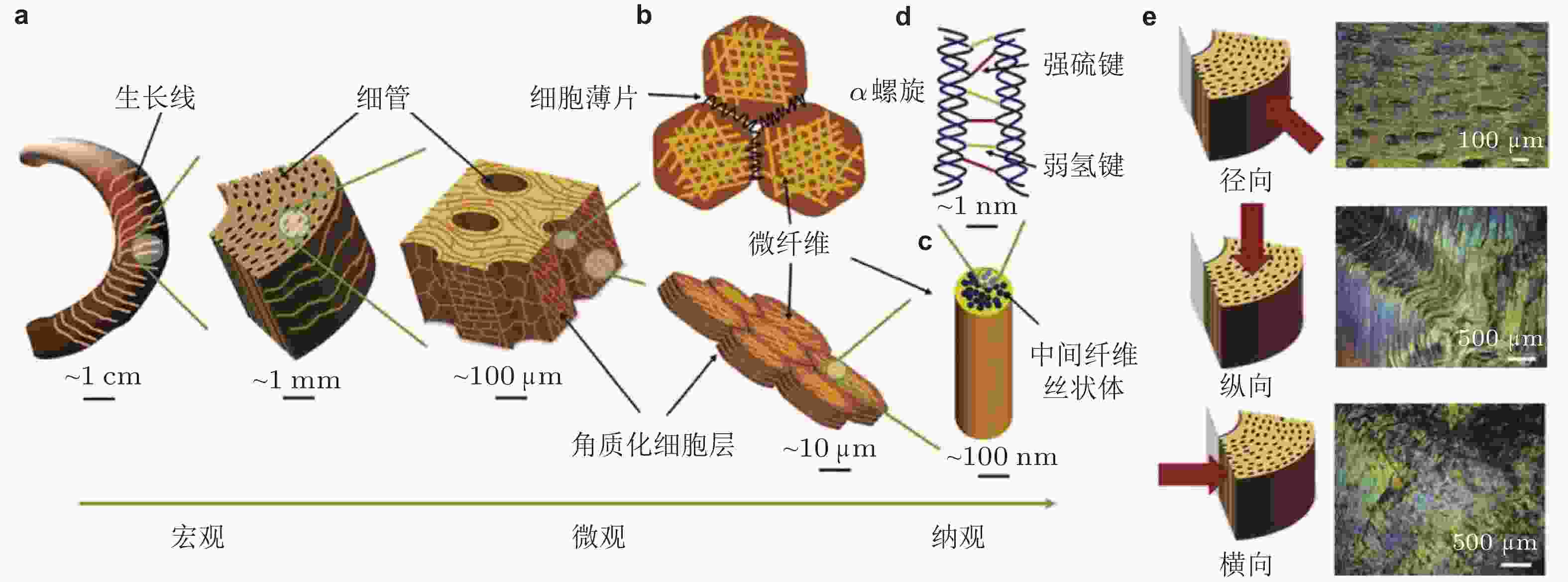

 下载:
下载:

